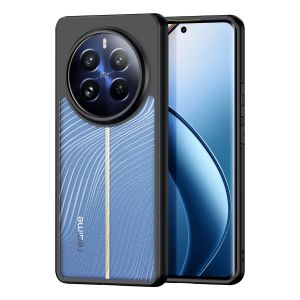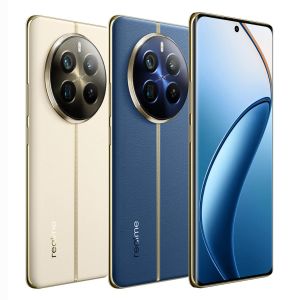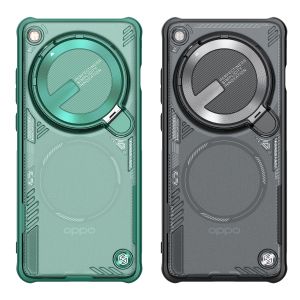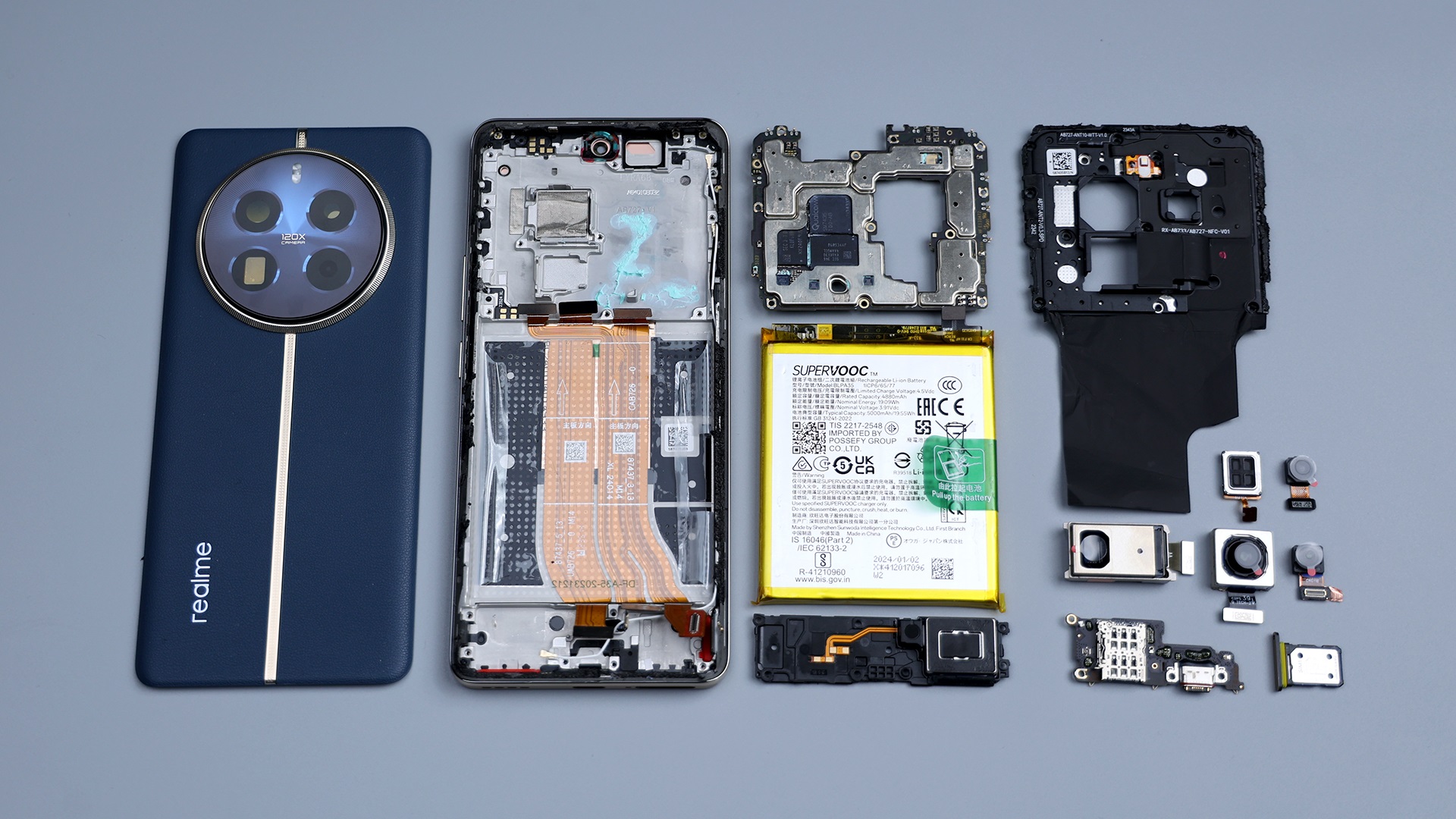
The star of this teardown is the just released Realme 12 Pro+. In the past few years, this product line of Realme has been focusing on imaging, and this 12 Pro series is no exception. As one of the oversized cups, what is the ID design and internal structure of Realme 12 Pro+? What are the adjustments and changes in product thinking and configuration planning compared to its predecessor? Below, we will analyze it by way of disassembly.
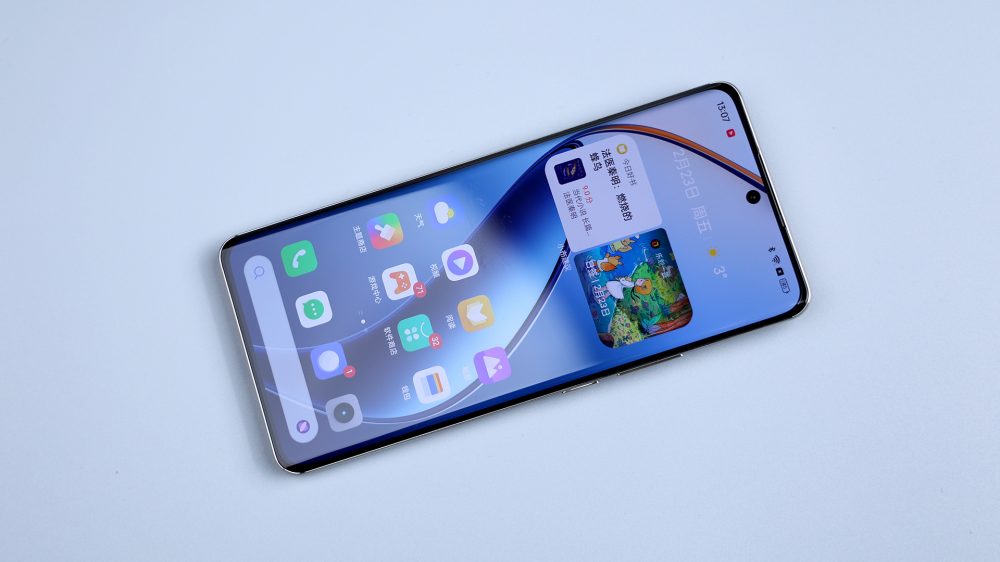
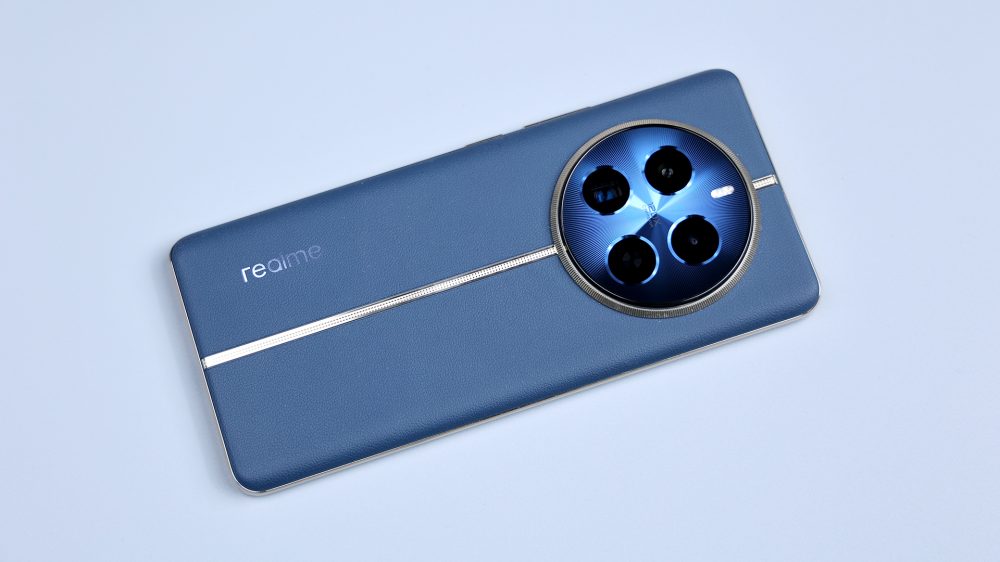
From the intuitive visual presentation point of view, the overall shape and line profile of the Realme 12 Pro+, basically a continuation of the style of its predecessor, the front dual-curved screen and the back of the dual side of the large curvature of the closing arc, the center frame is made of plastic, and the initial feeling of the hands is very thin and light.
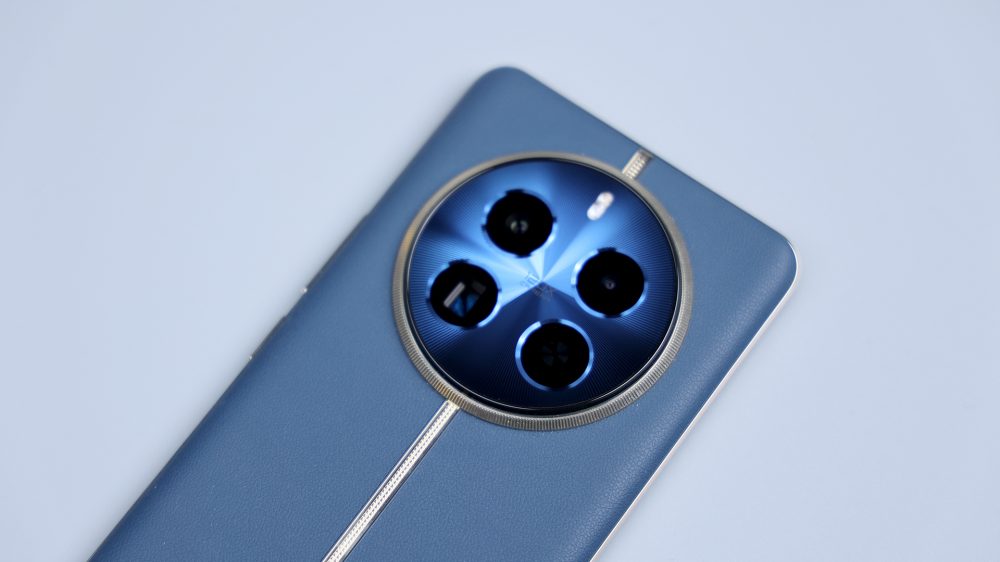
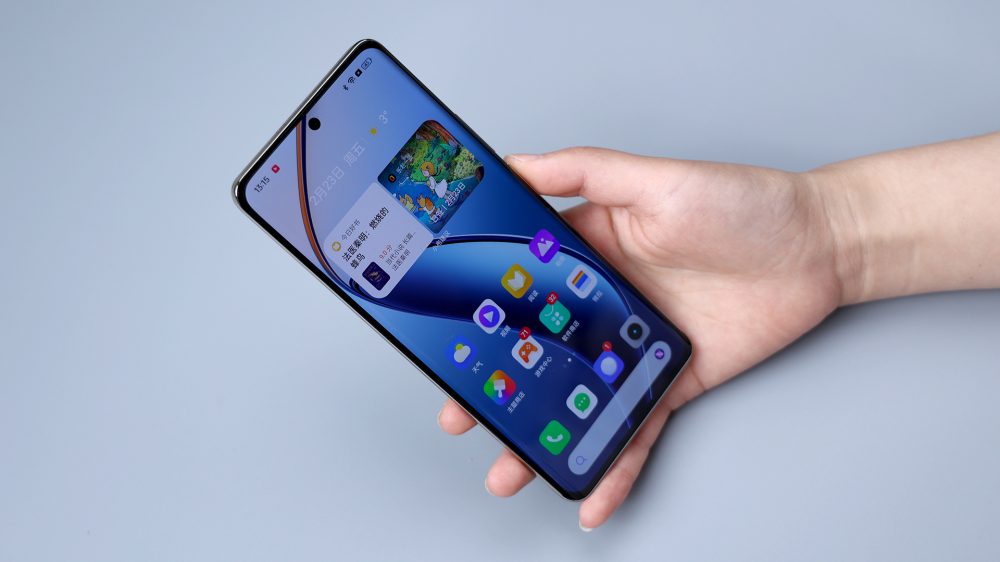
The surface of the back cover is made of vegan leather, and the center line running through it divides it into two, with the round rear camera module placed in the upper center. As an upgraded product, the changes of the Real Me 12 Pro+ are mainly reflected in the details, first of all, the lens position and arrangement, from the horizontal lined up, adjusted to the combination of upper and lower 2+1, the lens ring from the flat glossy surface, changed to a fine texture, the center line from the three-dimensional stitching, changed to a diamond pattern splicing similar to the metal strap, the mirror surface fused with the light cone texture and gradient UV texture, these three aspects are exactly the official mention of the luxury watch design.
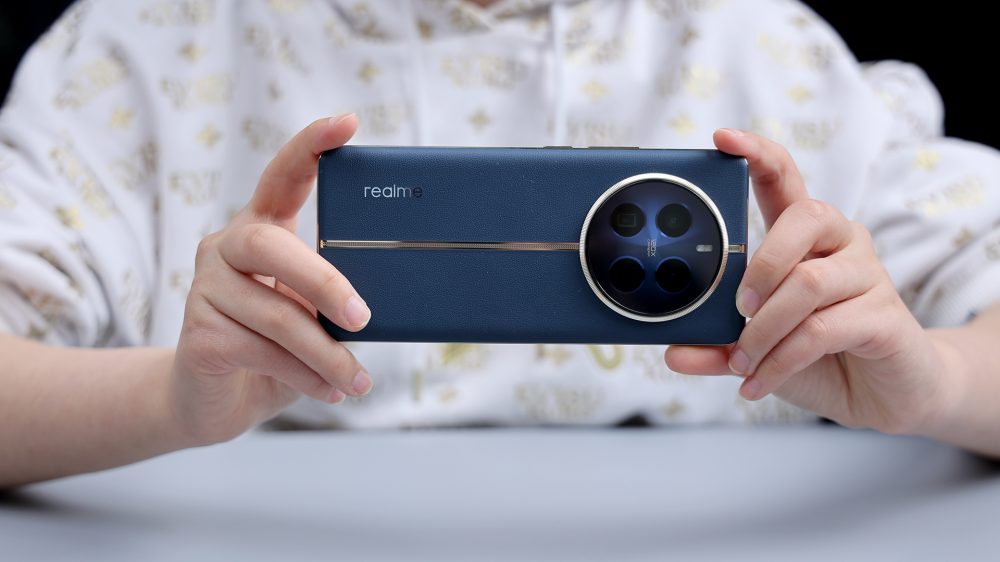
In contrast, what impressed me more was the vegan leather of the back cover, without that cheap plastic feeling and hard texture, touching softness and elasticity, it is indeed very much like leather, and the sense of fit and damping in the hand is very strong.
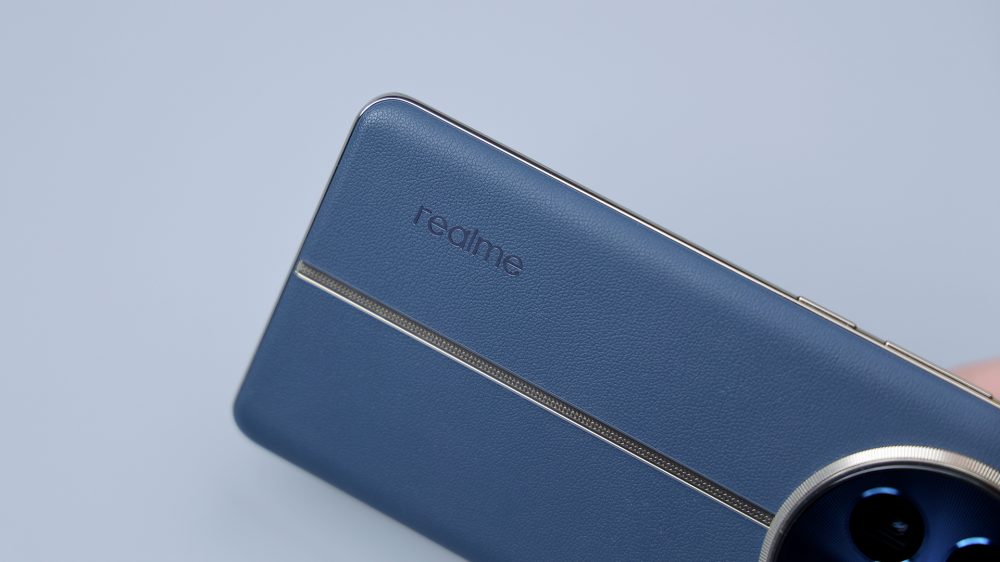
Here is the beginning of the disassembly. After turning off the phone, take out the SIM card tray, double nano stack design, plastic bezel and frame + metal bezel, with a yellow dustproof and waterproof rubber ring.
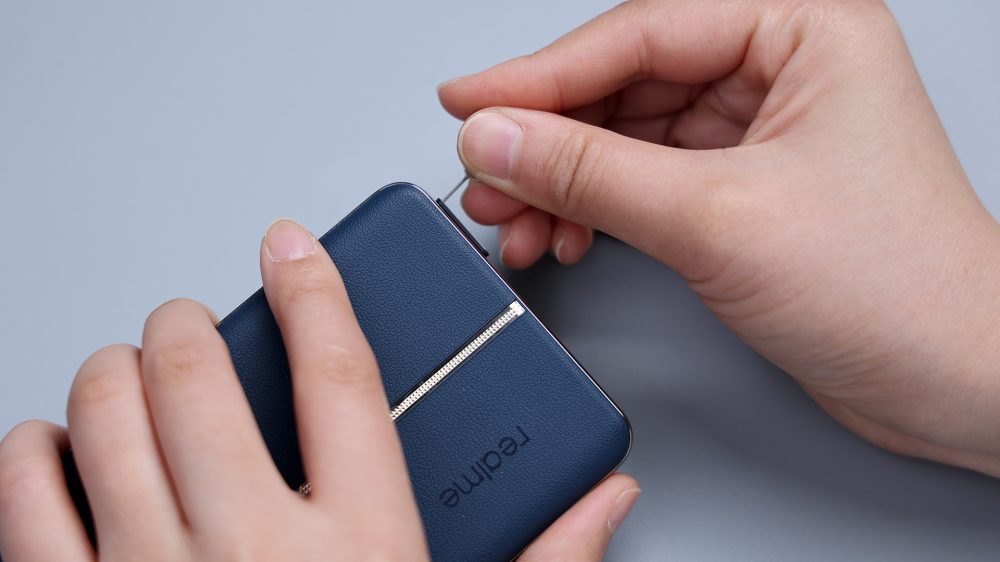
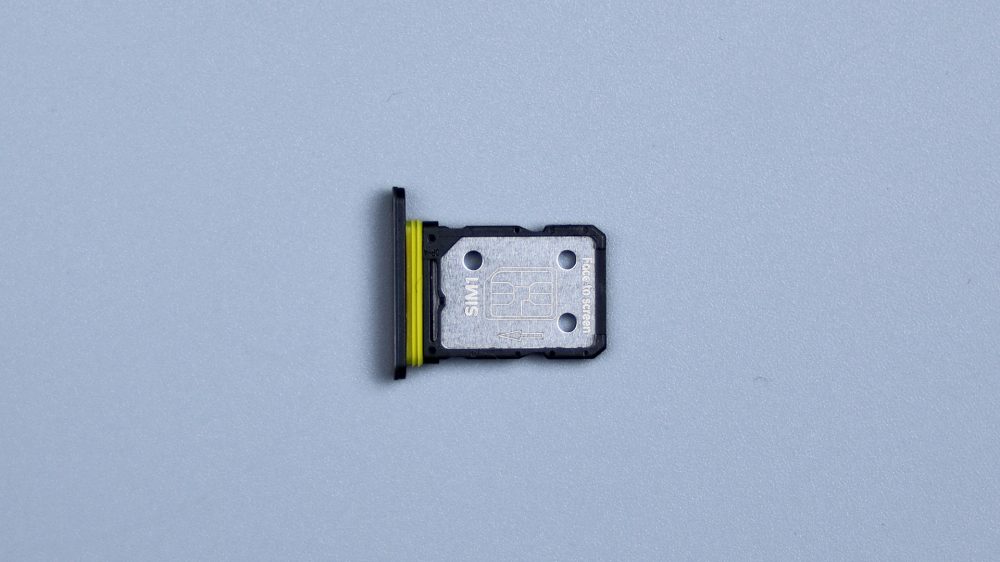
The protruding mirror set makes it impossible to lay the phone flat on the heated plate, and you also have to start with the lower center.
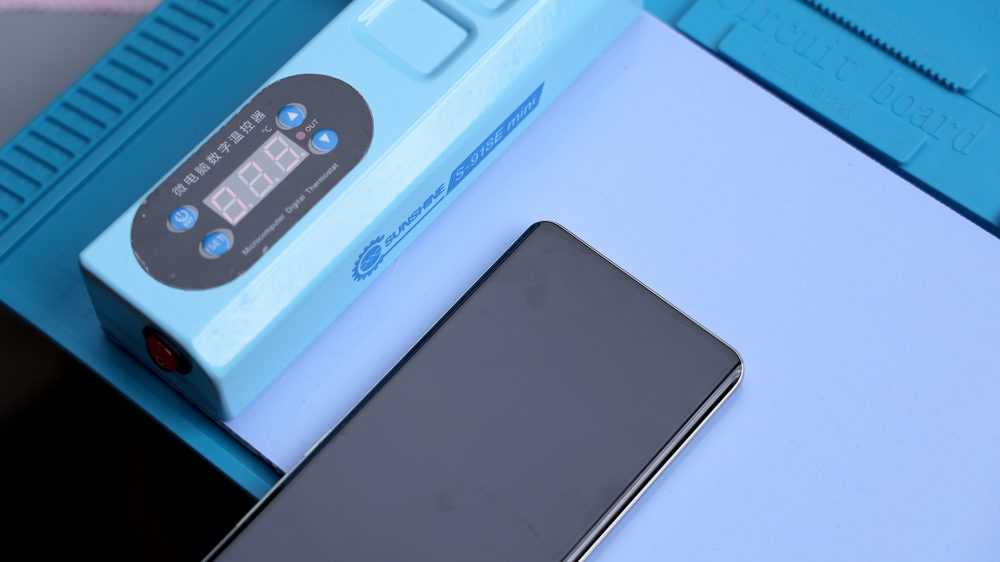
After heating, the adhesive gradually soften, but the back cover is still very tight around the adhesive, so you can only use the thin metal warps to open the breakthrough, and then replace the plastic warps to move forward, in addition to the bottom two corners of the slightly difficult, left and right under the three sides of the difficulty, the speed is not very fast, but did not encounter any resistance. Difficulties appear in the upper part, from the feedback on the hands of the strength of the lens around the lens has a separate spot glue bit, large area, sticky, repeated heating twice before completely cleaned up, successfully open the back cover.
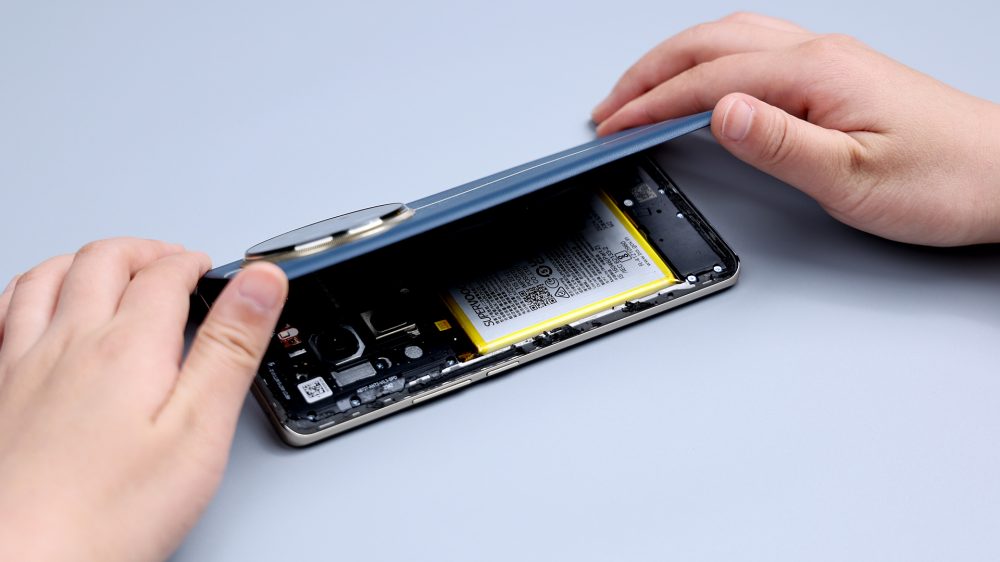
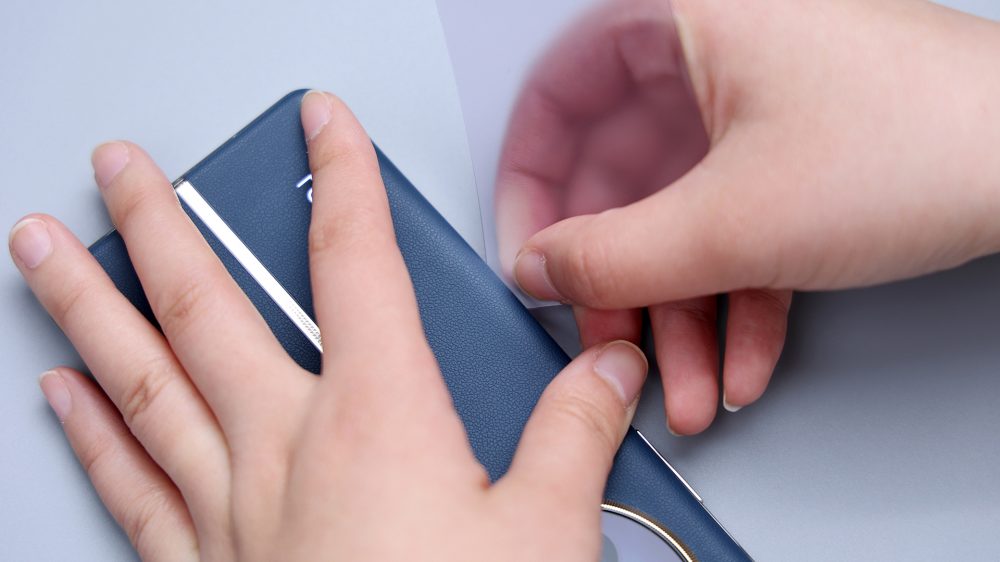
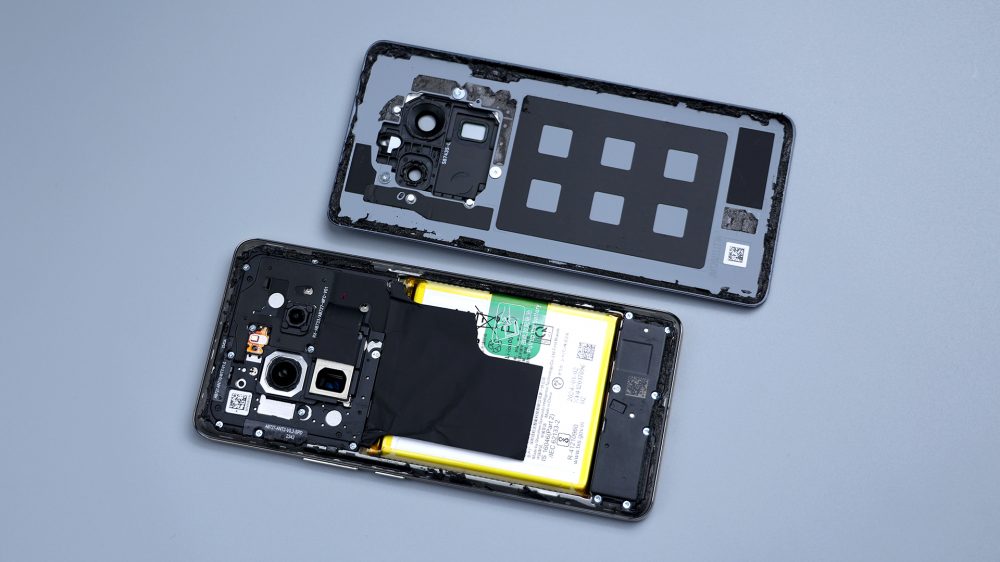
The back cover as a whole consists of two parts, the gray block of plastic lining, equivalent to the overall framework of the back cover, surrounded by a circle of wrapped edges is the edge of the contour molding, and in the middle of the two vertical wrapped edges across the top and bottom, forming a shallow groove for placing the gold decorative band, the same area on both sides of the block paved with vegetal leather, fixed by a large number of adhesive, and close enough to see the distinctive boundaries between them.
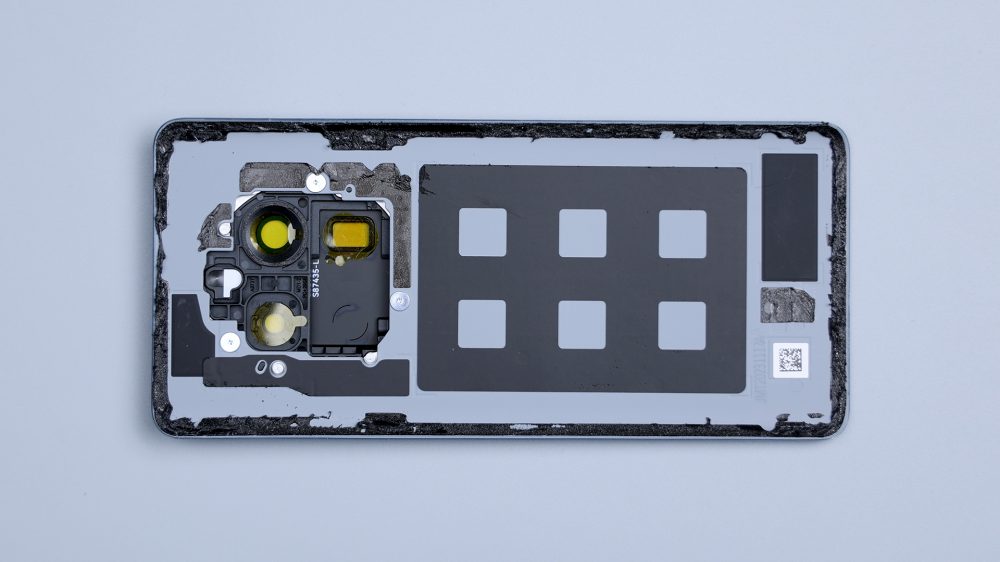
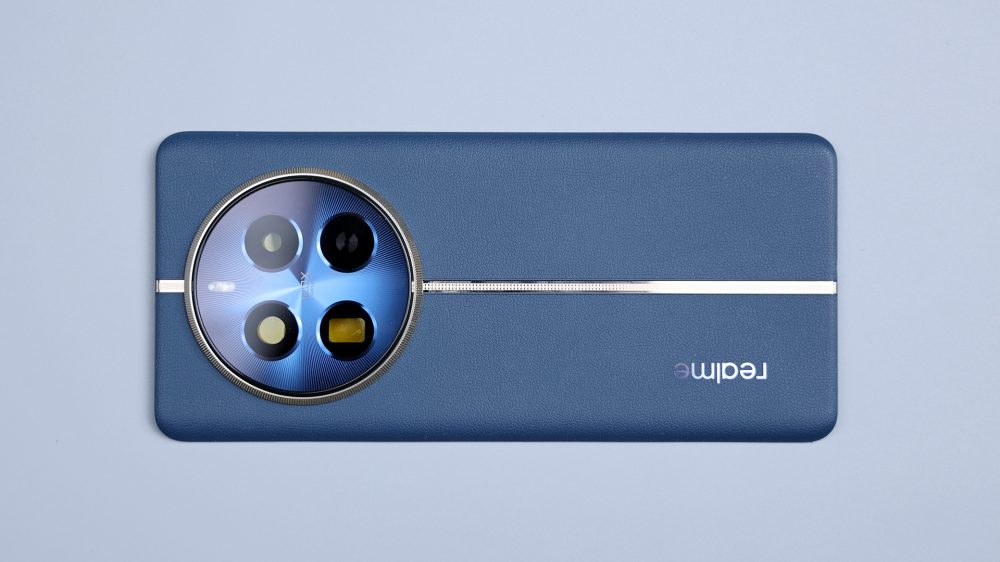
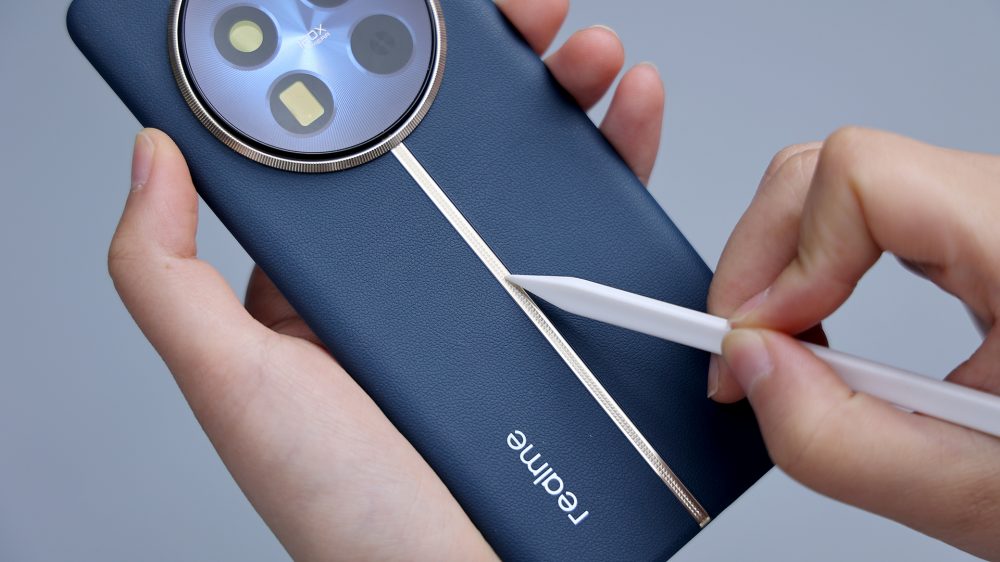
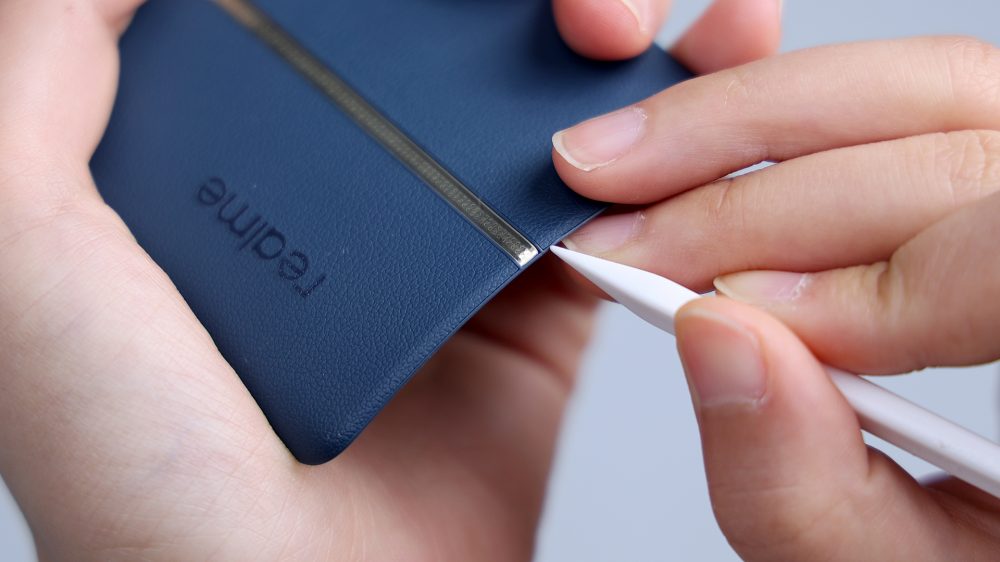
The nature of the material makes the overall back cover flexible and malleable, and a slight pinch can create deformation, which makes it fit more tightly on the center frame.
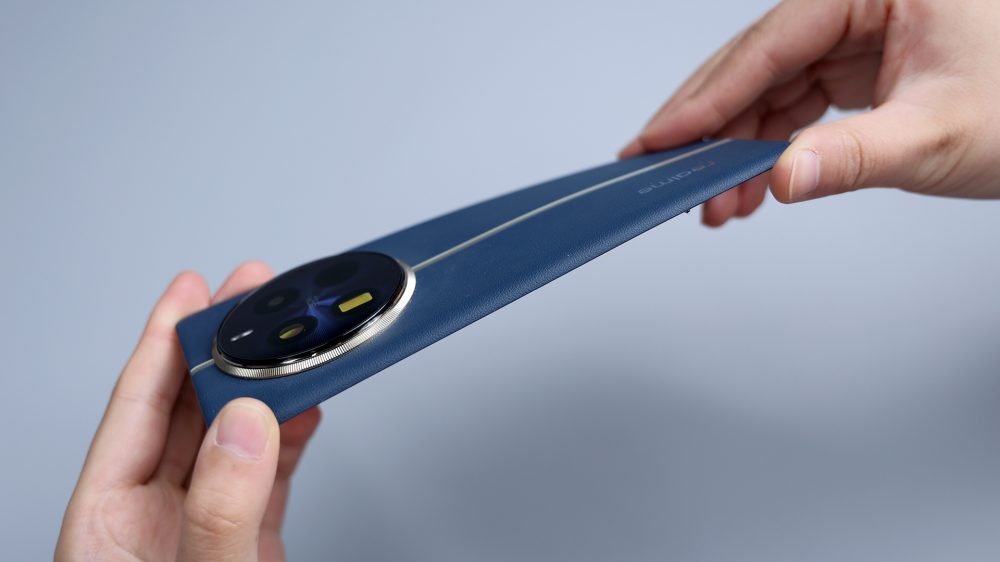
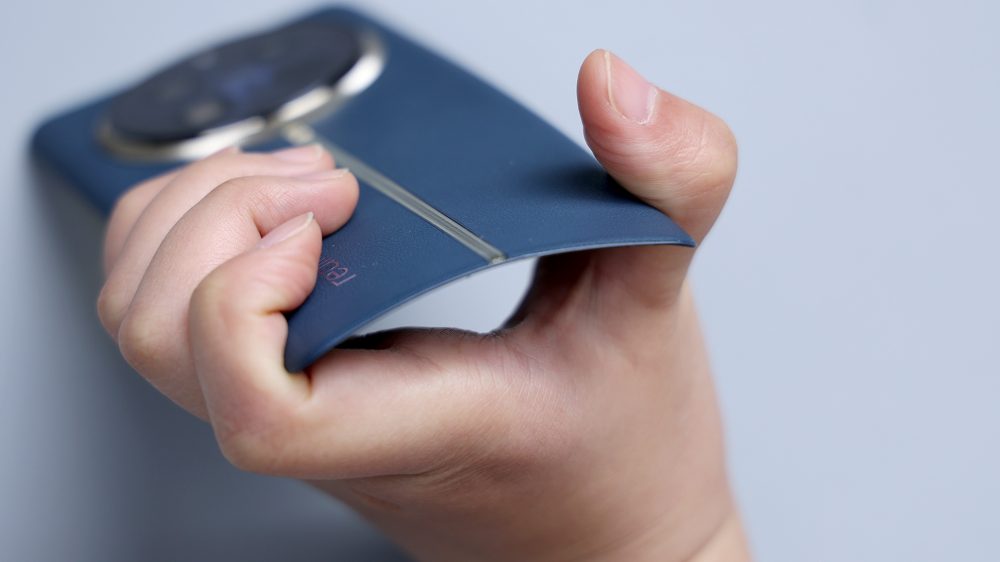
The rear of the Realme 12 Pro+ adopts a triple-camera solution, while there are four black rings in the lens area.Facing the light source, you can see that the corresponding ring of the triple camera is transparent, and the remaining one is used for decoration, so it's not made transparent.The logo is assembled in the same way as the GT5 Pro, except that the position has been adjusted to the lower left corner.
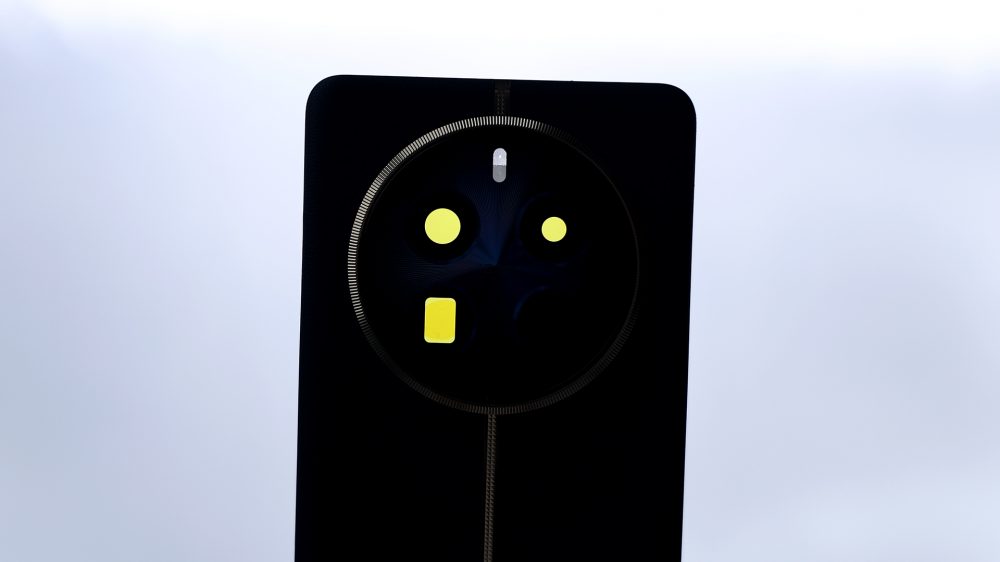
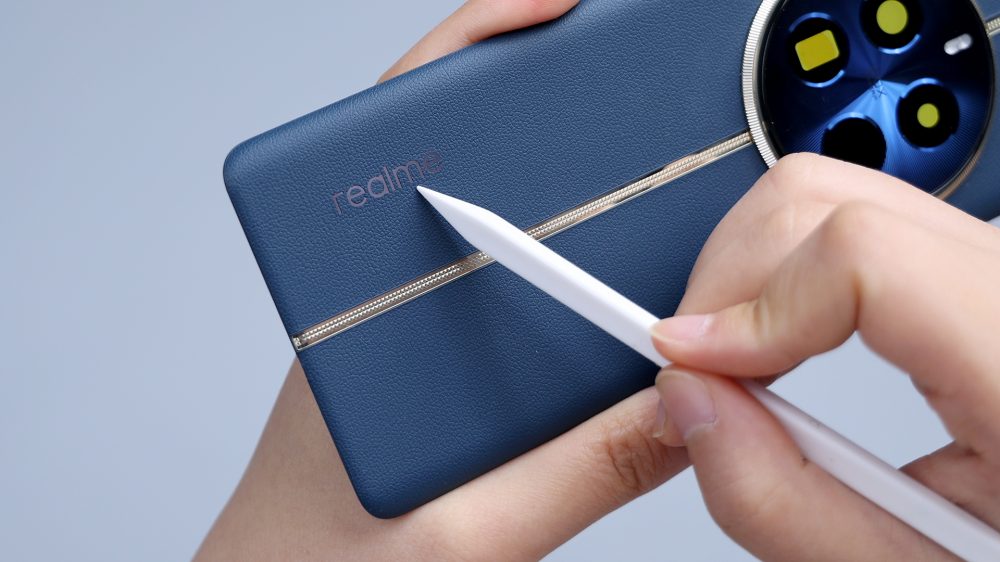
The circle of adhesive around the inside of the back cover is wider, and from the folds and knots, you can see that it's very sticky. As previously speculated, the adhesive near the camera is not only wider, but also, the right side of the main camera and under the telephoto lens, as well as the secondary plate area, set up a separate spot of adhesive, the adhesion is even stronger than the surrounding adhesive.
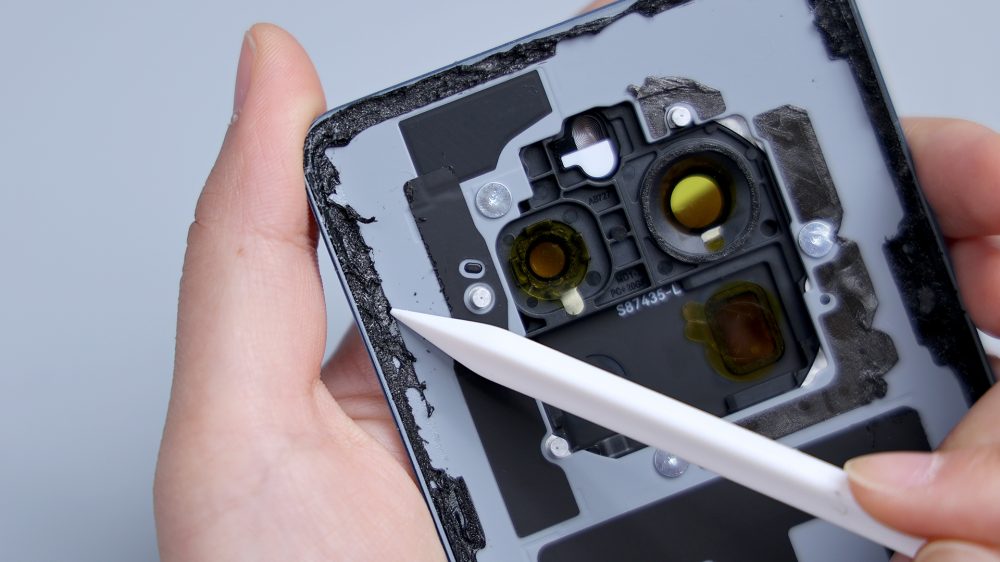
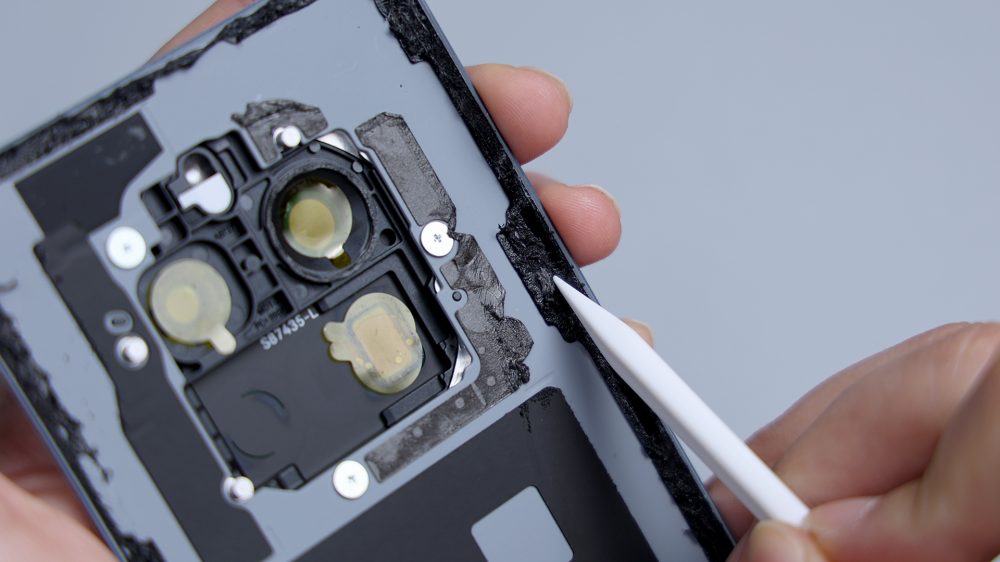
On the upper left and lower right, there is a piece of heat sink film each, corresponding to the upper and lower speakers. On the left side of the ultra-wide-angle lens, there is a long strip of foam corresponding to the NFC coil, and a large rectangular piece of foam in the center corresponds to the battery, which all play a role in cushioning protection.
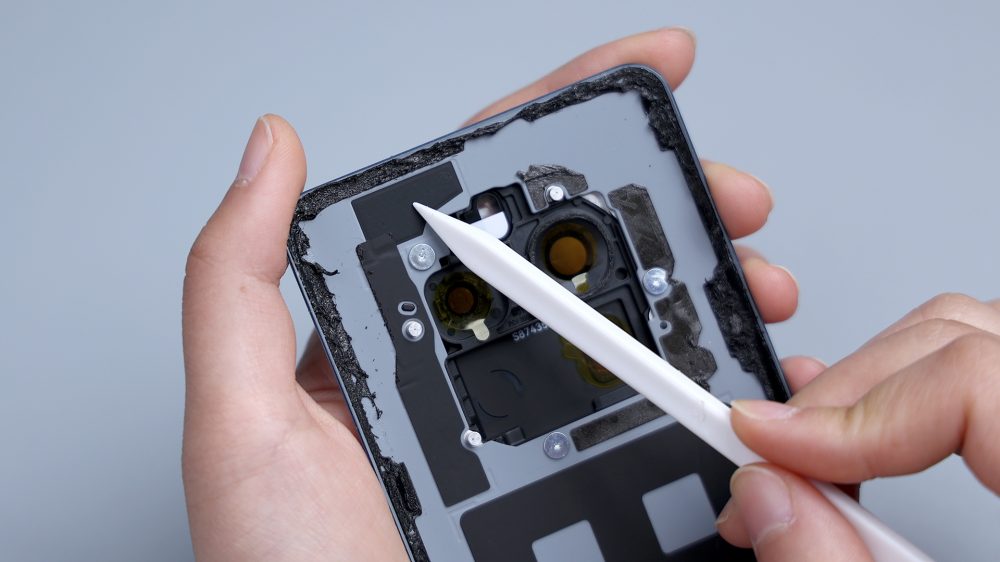
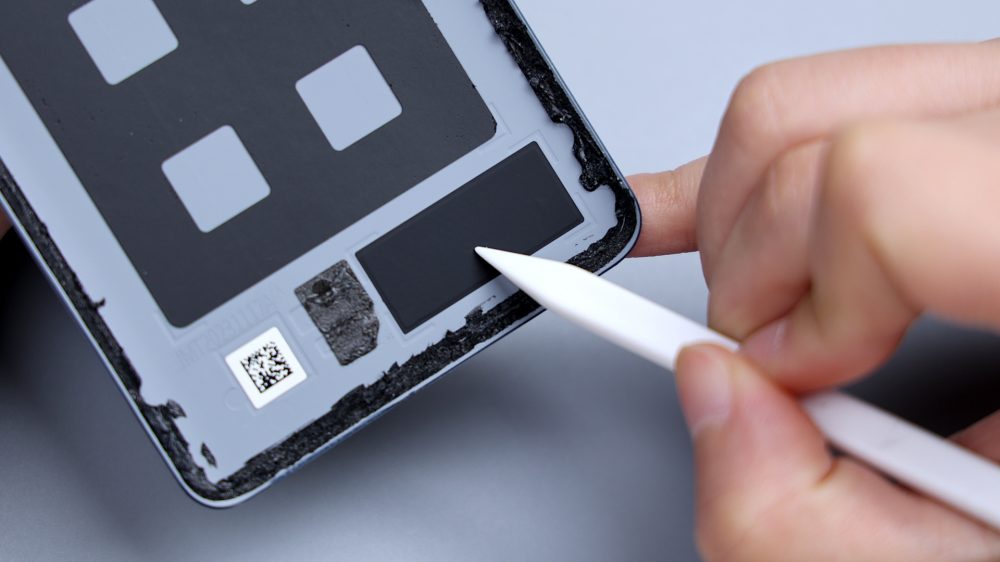
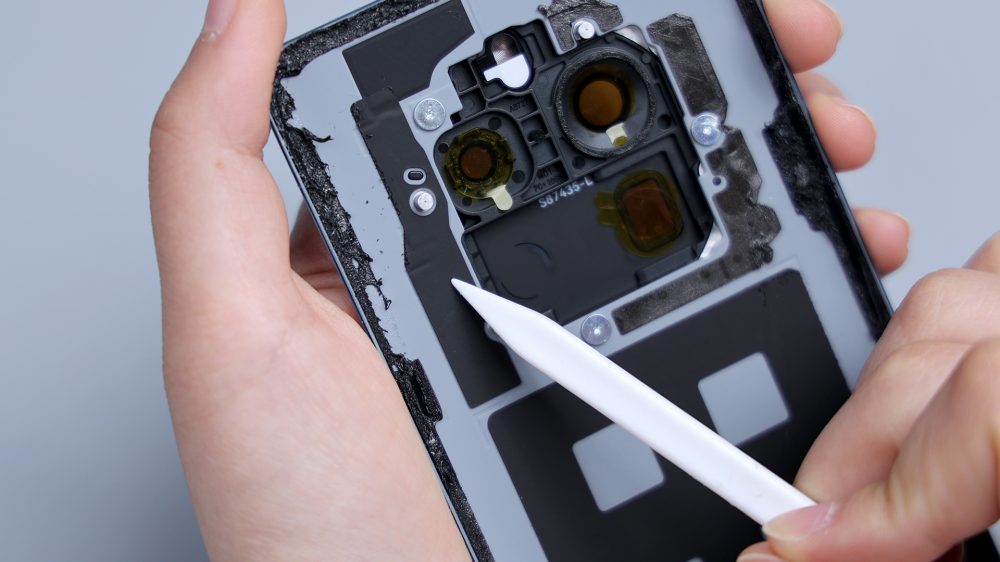
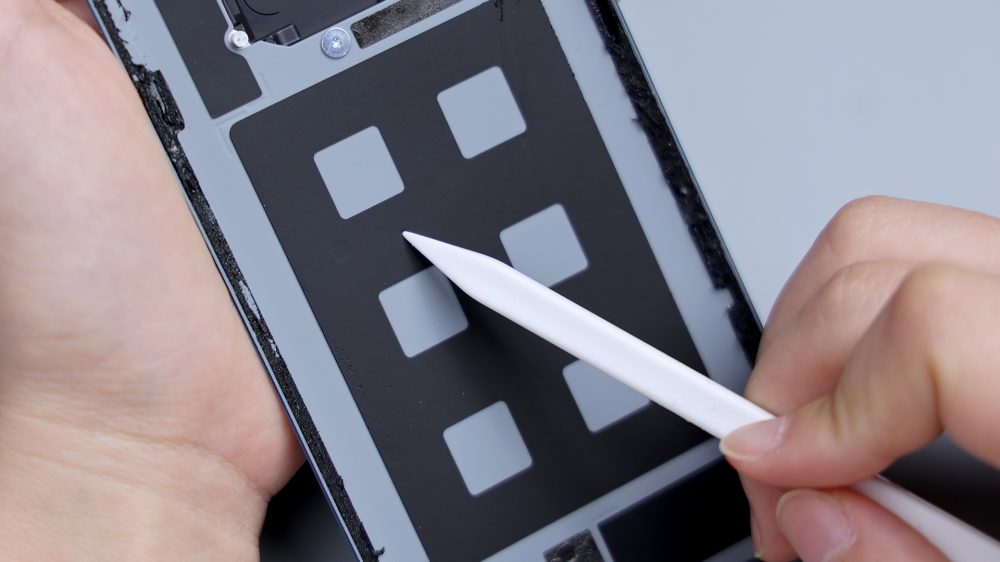
The inside of the DECO has a black plastic liner, which is assembled using a dual assembly of 3 screws + adhesive. Unlike the previously disassembled phones, the edges of its liner are smaller than the DECO opening, and it doesn't have the Oreo sandwich effect with the outer frame.
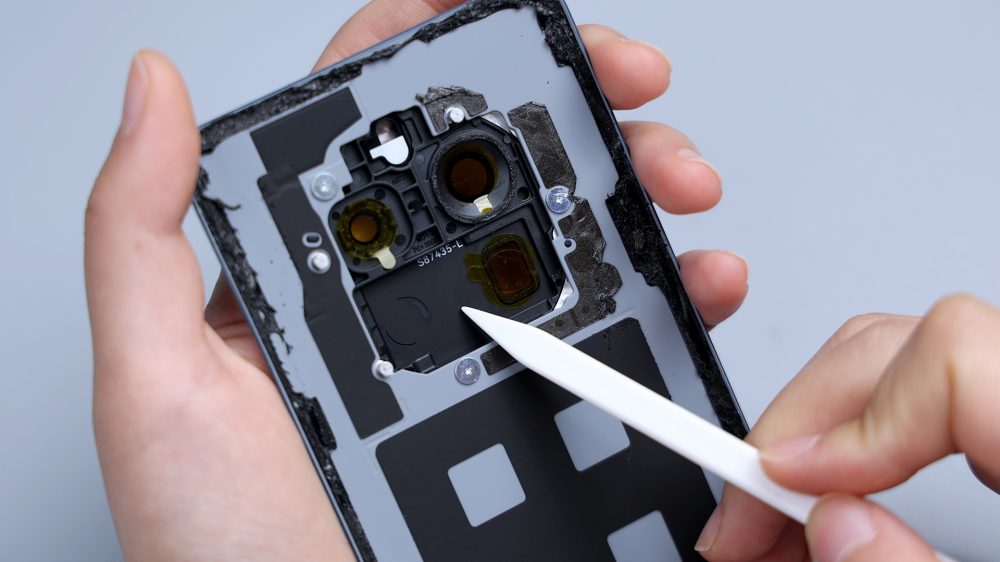
From the glossiness of the exposed part of the edges, it can be seen that the main body of the DECO is made of metal, molded in one piece by CNC process, with 3 metal limiting pillars distributed around it to assist in the assembly of the back cover, and it also shoulders the work of signal conduction, which corresponds to the 3 metal shrapnel in the main body of the phone.
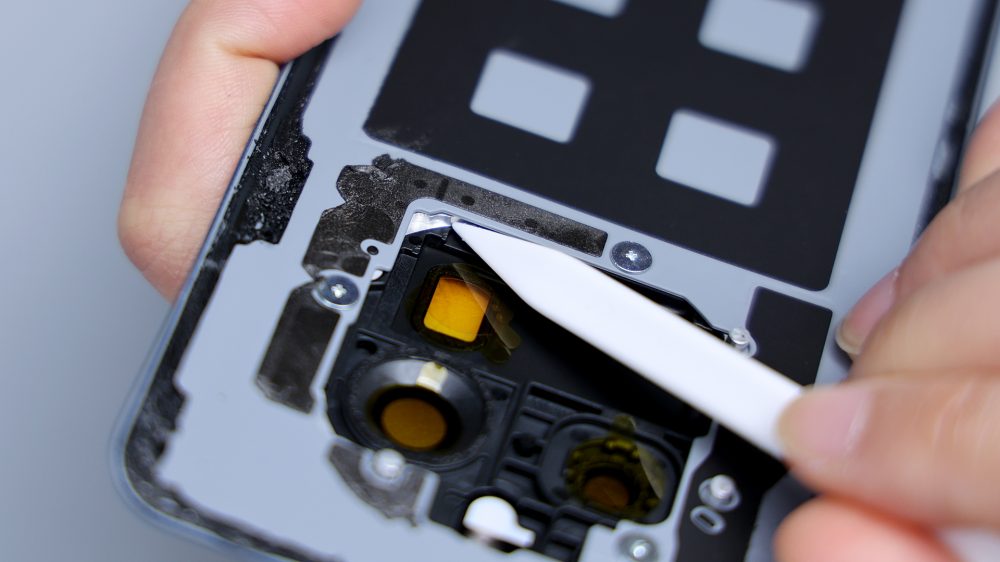
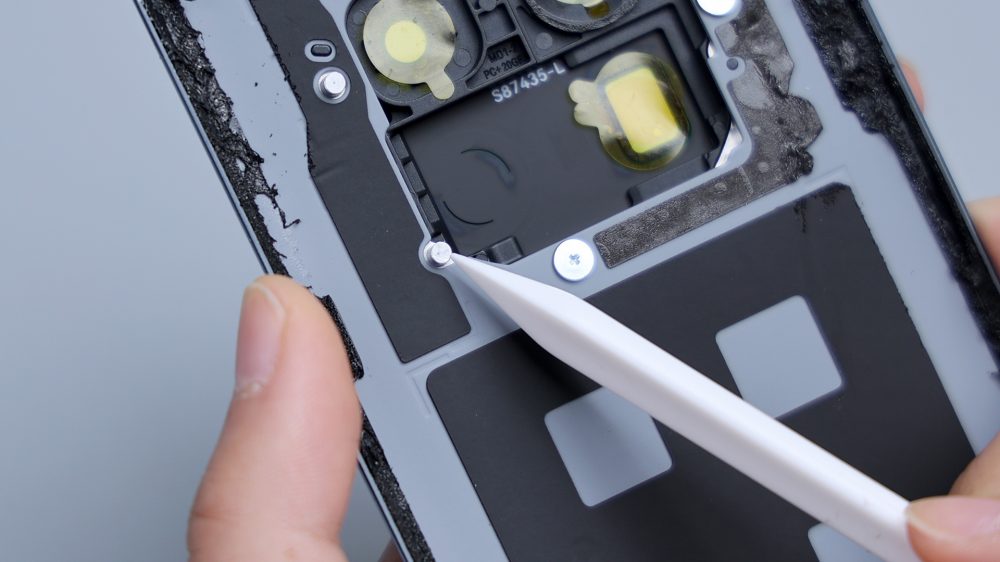
3 lenses corresponding position are protected by foam ring, the top of the oval hole corresponds to the flash, the outer side looks as if they are transparent, giving people an illusion of dual-LED, in fact, the inside is covered by half, which is not only aesthetic issues, more or less a bit of mystery meaning. There is another detail in the position of the telephoto lens, as with the Xiaomi 14 Ultra, there is a semi-circular arc of indentation, I do not know what purpose it serves.
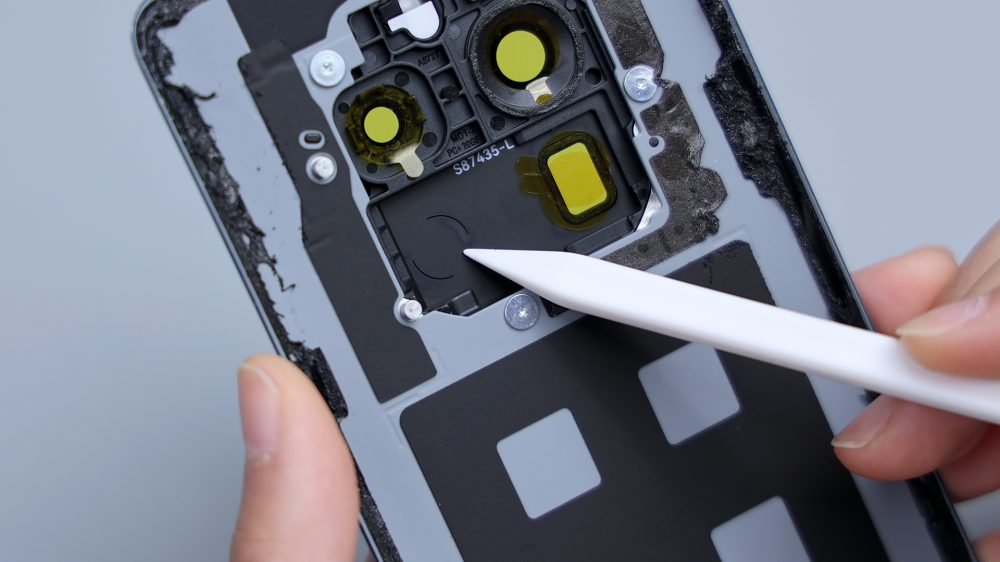
There's the same adhesive residue around the body of the phone, and the cover is secured by 11 screws.
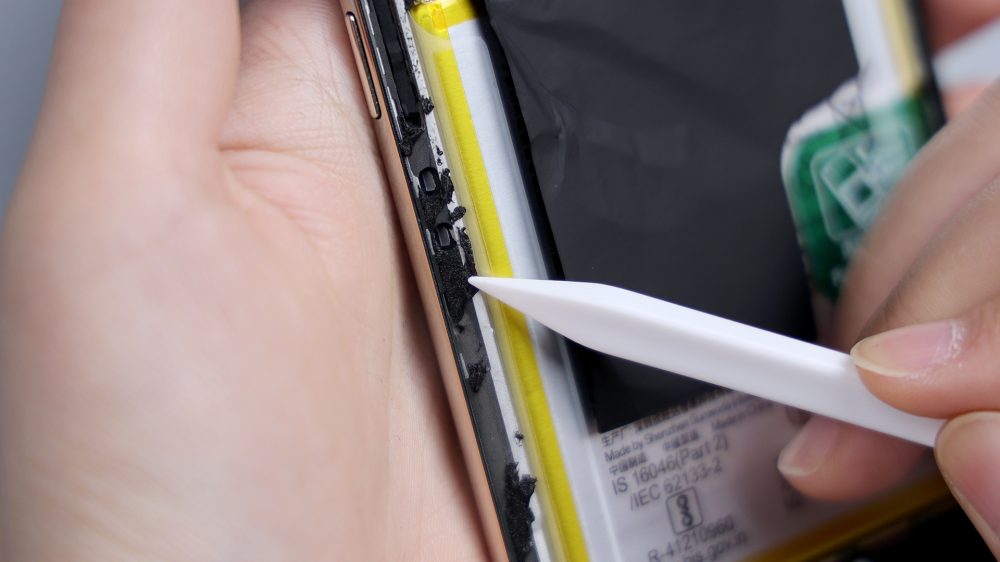
There is 1 antenna FPC on the left side and 1 on the top. the NFC coil is located on the top right, wrapping the ultra wide-angle lens around it. On the left side of the main camera, you can see part of the metal plate is exposed to aid in heat dissipation and signal overflow, and the corresponding metal shrapnel for the limiting post is distributed against the right side. The flash is at the top left of the main camera in a single LED bead configuration.
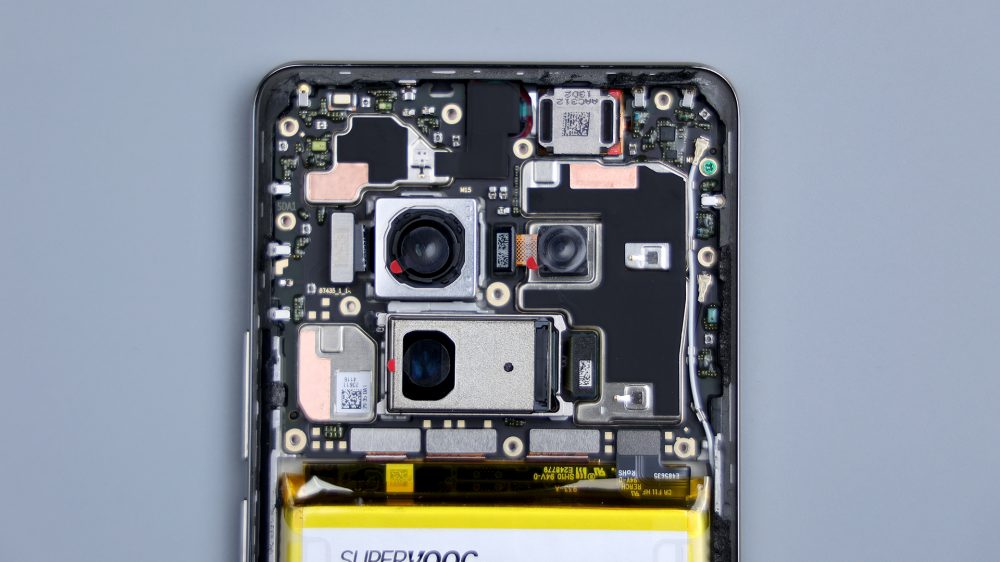
Confusingly, there is no rear ambient light sensor to be found around.
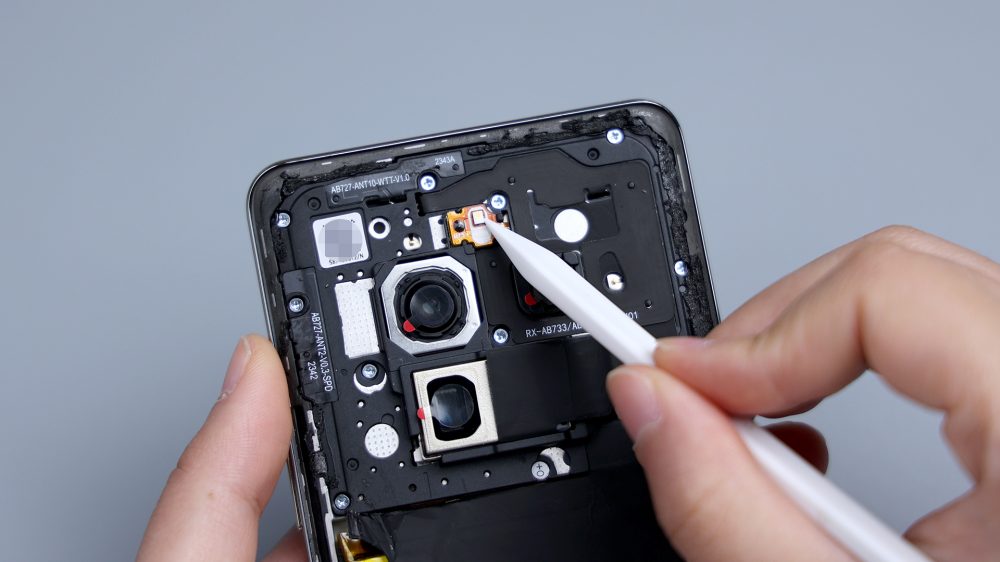
There's a heat sink film in the center that covers 60% of the battery and extends upwards to cover most of the area of the periscope telephoto and NFC coils.
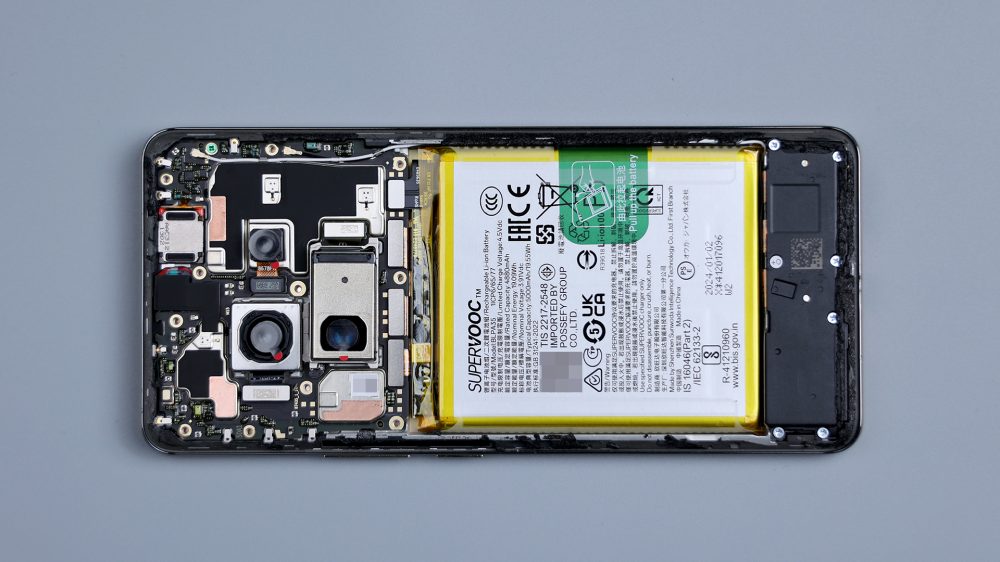
Unscrewed all the cover fixing screws and pried up to remove the cover.
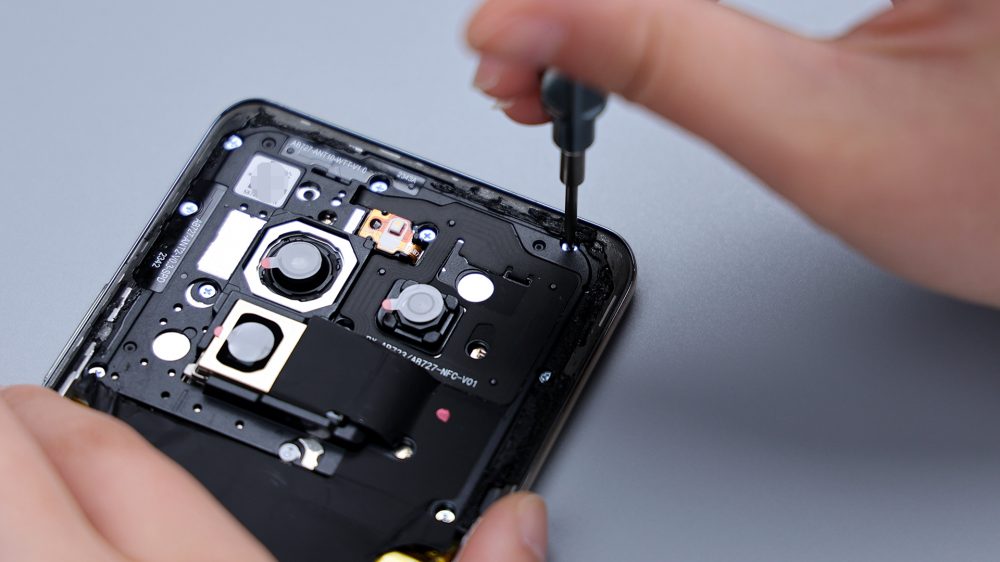
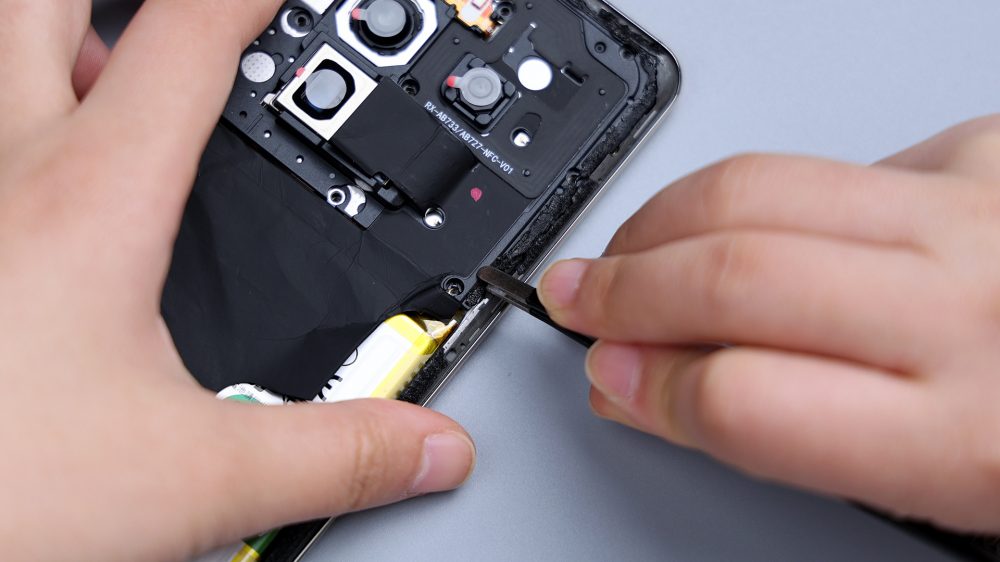
The inner side of the cover has a foam pad and foam ring corresponding to the speaker and front lens, respectively, to provide cushioning protection. The two contacts on the top right correspond to the top antenna FPC, the contacts in the center and top left correspond to the NFC coil, the 3 contacts next to the main camera correspond to the flash, and there is 1 piece of conductive cloth on each side of the left and right sides. The BTB corresponding to the main camera, ultra wide angle, and periscope telephoto lenses are protected by foam cushion buffers. The contact at the center position on the right side corresponds to another antenna FPC.
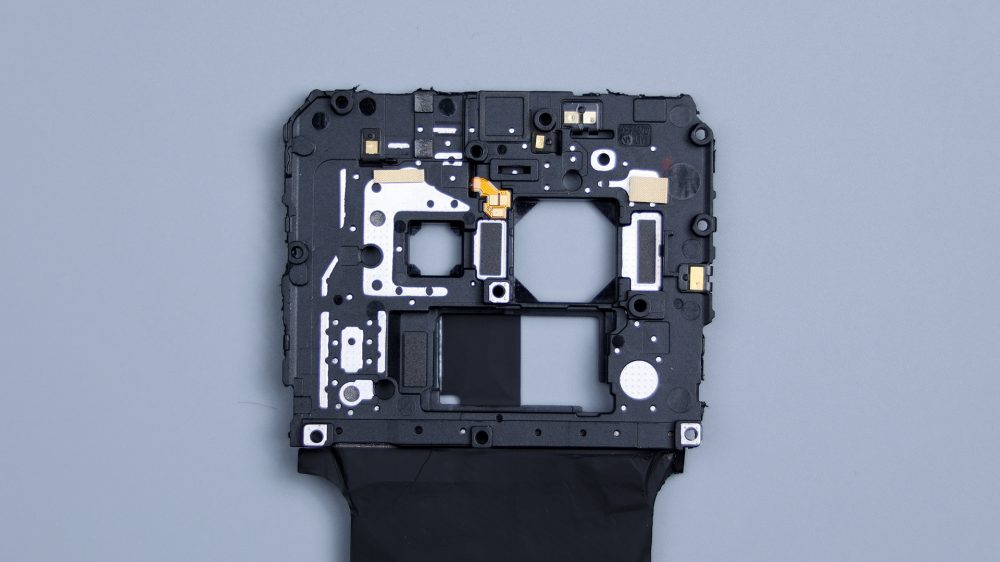
The main body of the phone is still the most conspicuous rear three cameras, in which the main camera and the periscope lens protrude significantly, as can be seen from the side, they have a special metal frame, which serves to fix and limit the role of heat dissipation and provides heat dissipation assistance.
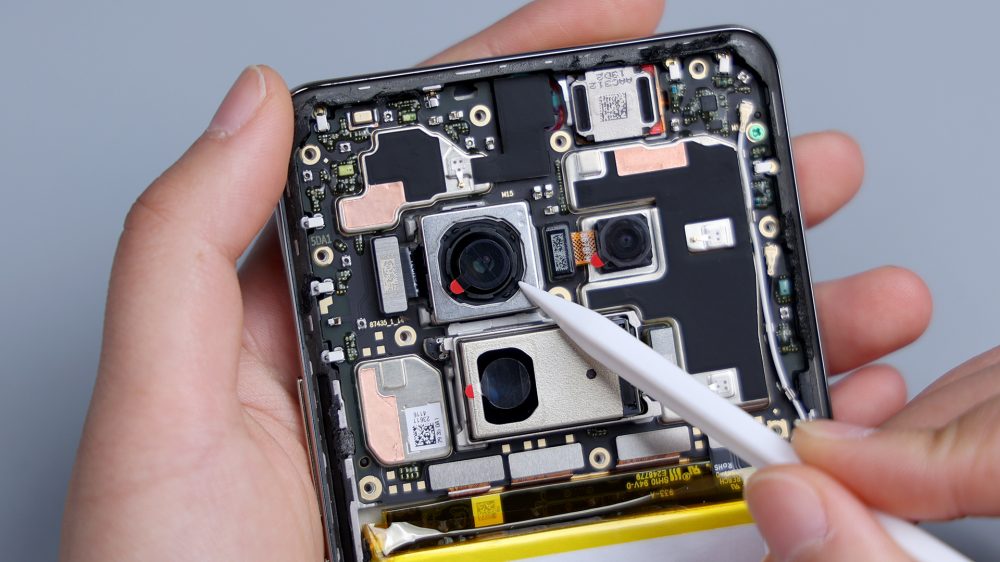
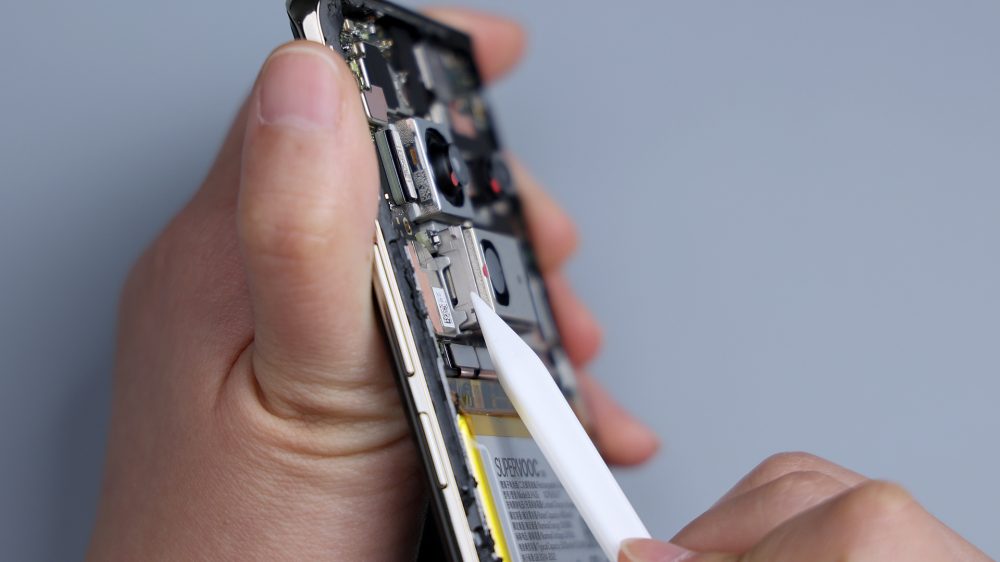
The ultra-wide-angle lens has neither adhesive nor additional fixing measures, relying only on an FPC attached to the motherboard, and the black square underneath is not foam, but is mainly used to pad the lens.
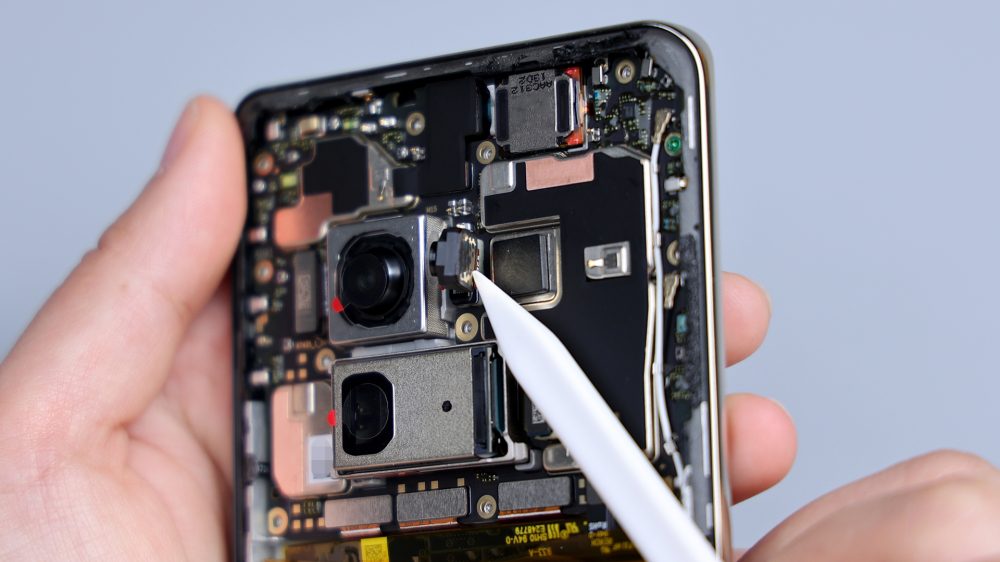
Smaller components and capacitors on the A-side of the motherboard are spot-glued, with metal shrapnel dispersed around the perimeter for signal transmission. The noise-canceling microphone is located in the upper left corner, with no metal cover on the outside. The front lens and the back of the BTB are covered with a thermal film, right next to it are the speakers, and on the right side there are two coaxial cables, one black and one white, connecting to the main and secondary boards. The motherboard has 1 separate fixing screw next to the coaxial cable connector. The shield on the A side of the motherboard is covered with copper foil and heat sink film, with all 3 metal shrapnel exposed.
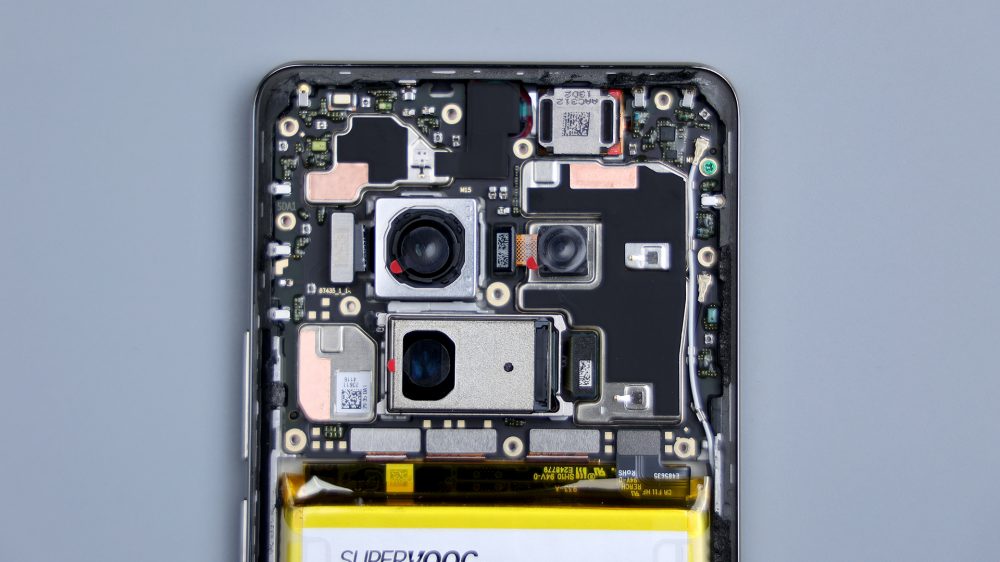
Disconnecting the battery BTB, then the left row and the front and rear quad camera BTBs, the ultra wide angle and periscope lenses can be removed directly, the main camera has adhesive to assist in fixing it, and the front lenses need to be removed by tearing off the heat sink film on the back.
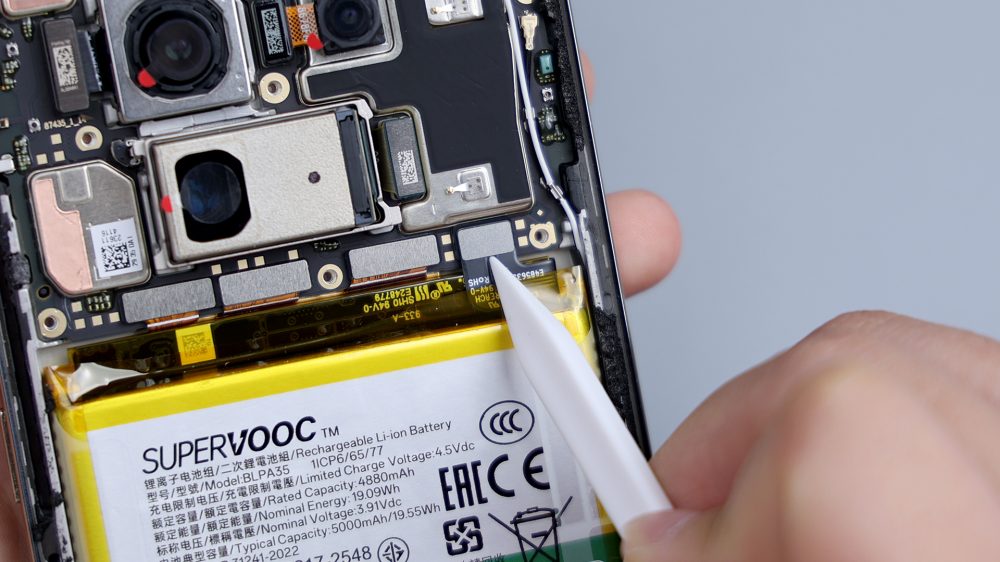
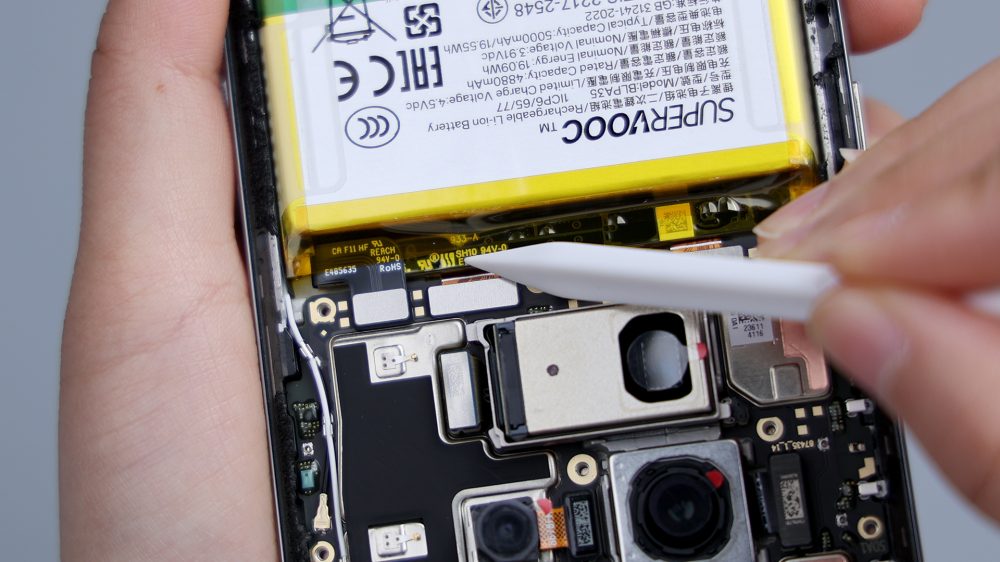
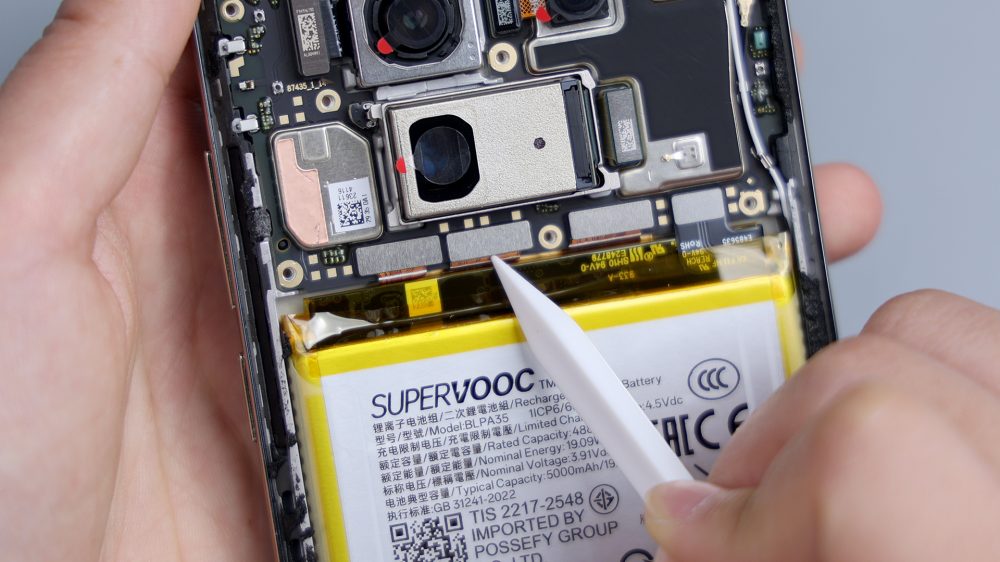
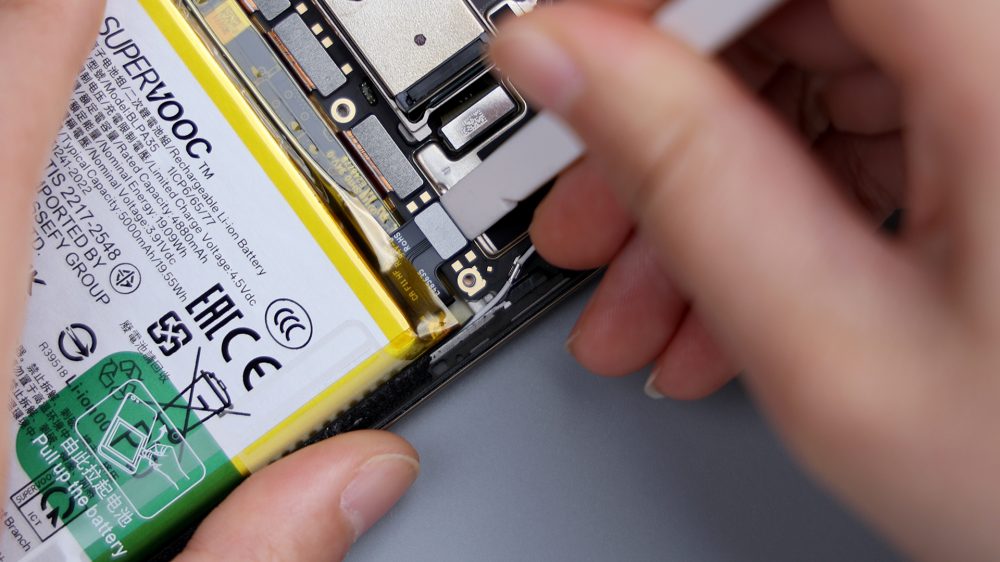
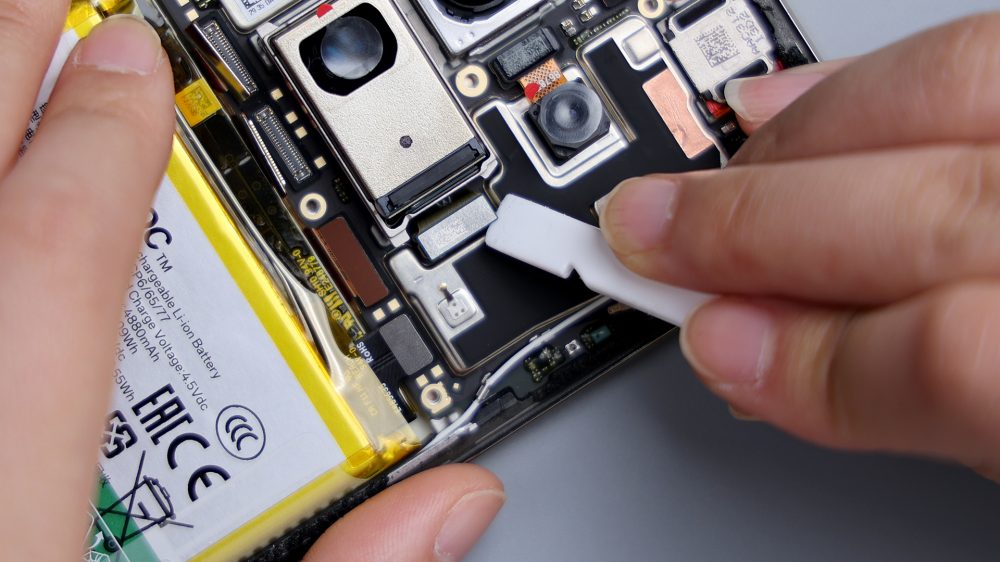
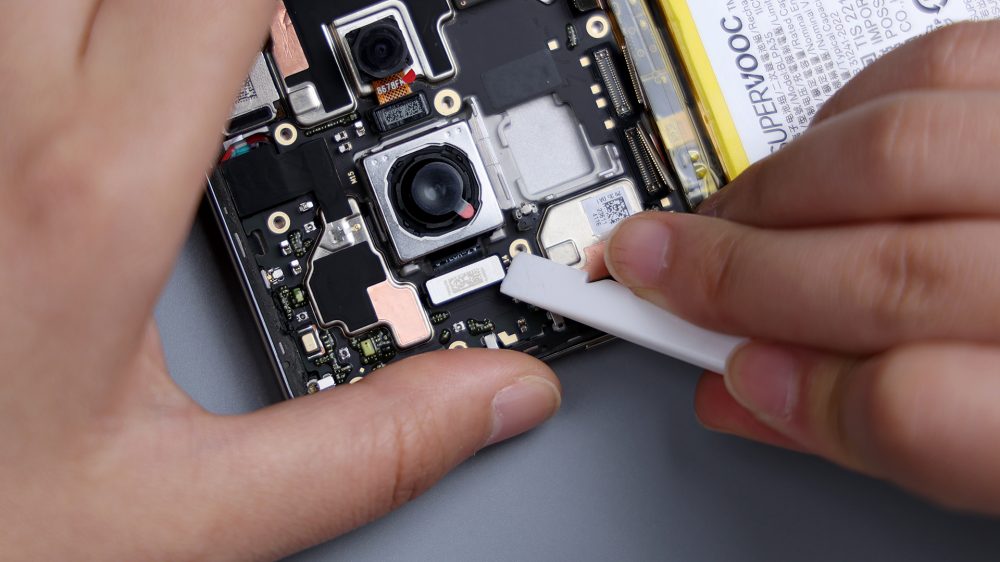
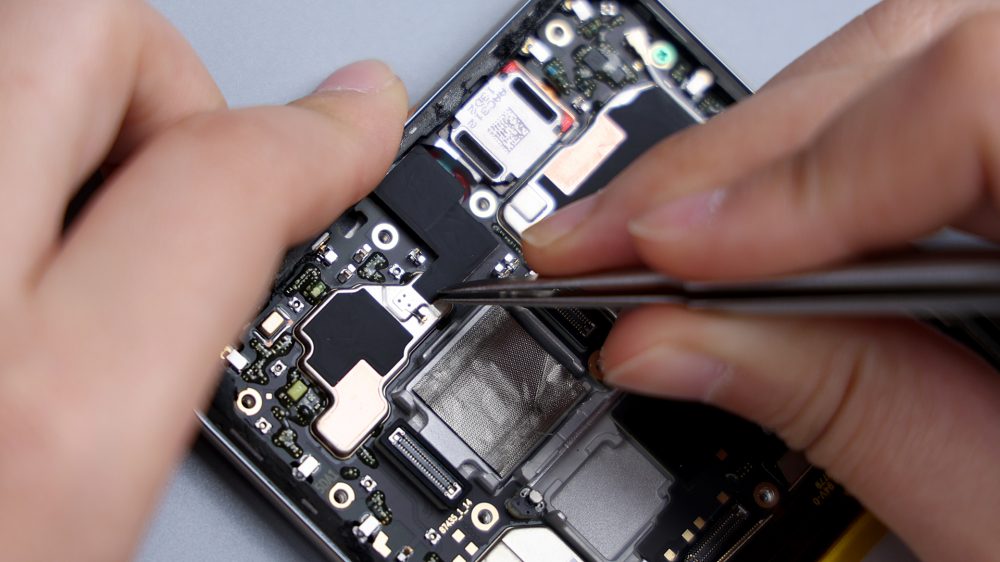
Once that's done, the Realme 12 Pro+ comes together with four front and rear cameras.50MP main camera, Sony IMX890 sensor, 1/1.56-inch outsole, supports OIS optical stabilization, 4-in-1 pixel fusion, and 2X lossless zoom.64MP periscope telephoto lens, Howey OV64B sensor, supports 3X optical zoom, 6X lossless zoom, and 120X Digital zoom, sensor area 1/2 inch, support OIS optical stabilization, EIS electronic stabilization and 4-in-1 pixel fusion, aperture f/2.6. 8-megapixel ultra-wide-angle lens, Hynix Hi846W sensor, this lens is a bit of a patchwork of flavors, because it has previously been used mainly as the front lens of the Tablet PC, like the Xiaomi Tablet 6, OPPO Pad, vivo Pad 2 front with it.32MP front lens, Sony IMX615 sensor, in line with its predecessor Realme 11 Pro+.
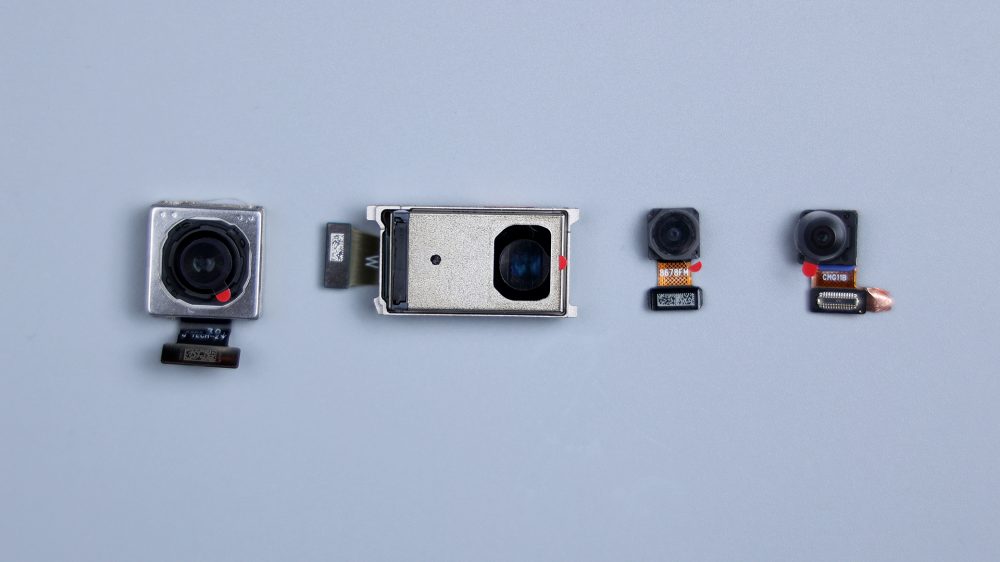
The disassembly continues by disconnecting the two coaxial cables on the right side, unscrewing the motherboard fixing screws, and prying up to remove the motherboard.
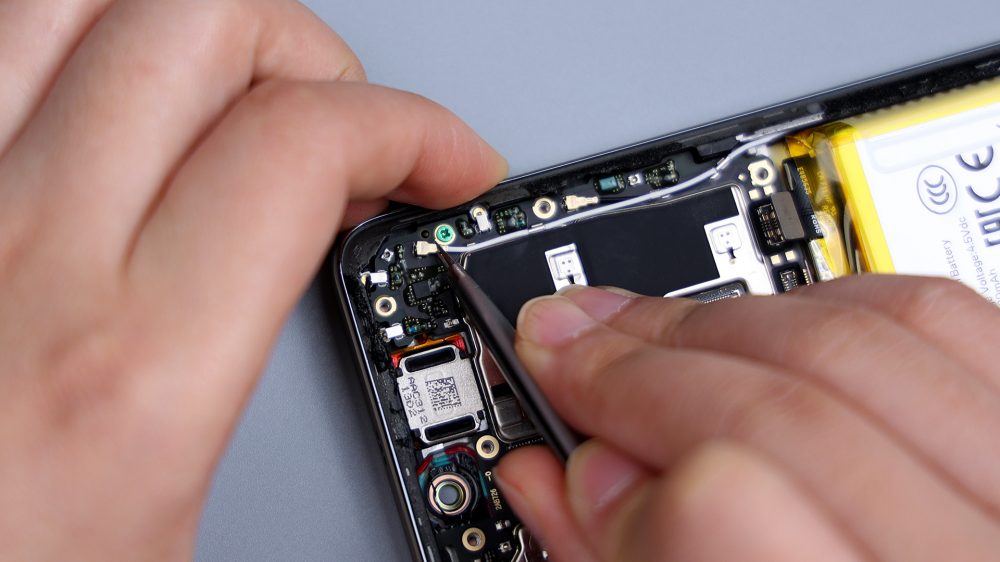
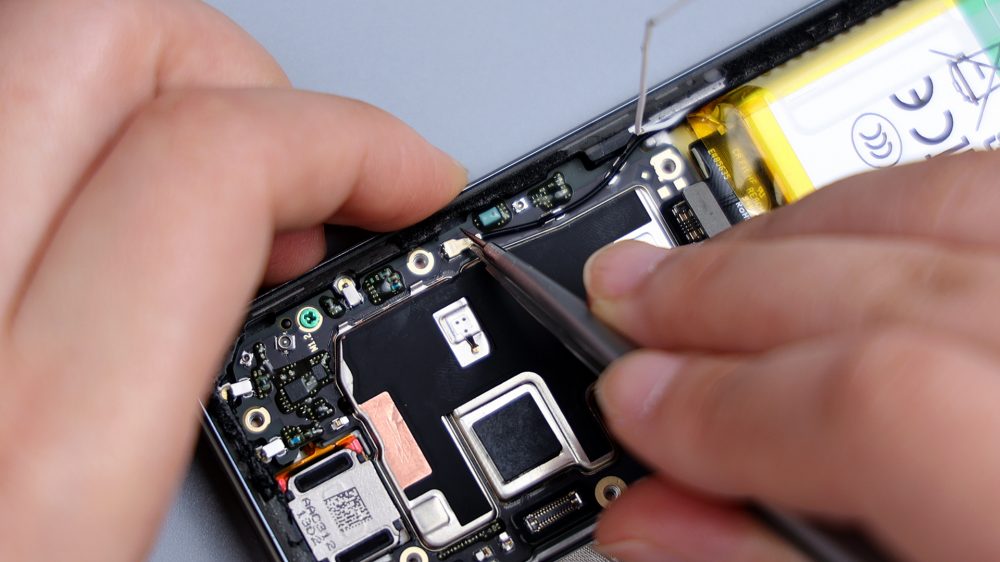
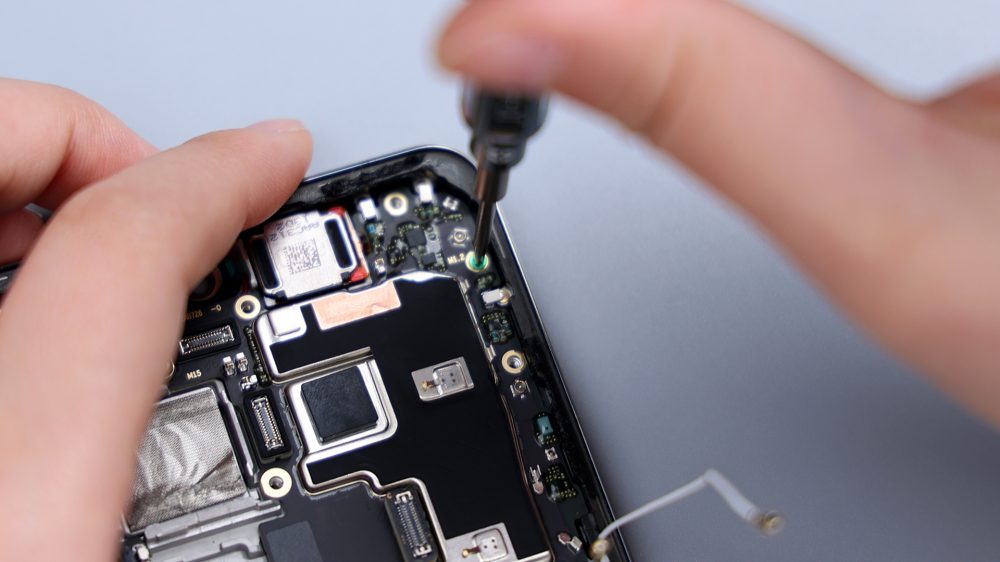
All BTB ports on the A-side, including the battery, are protected by rubber rings.
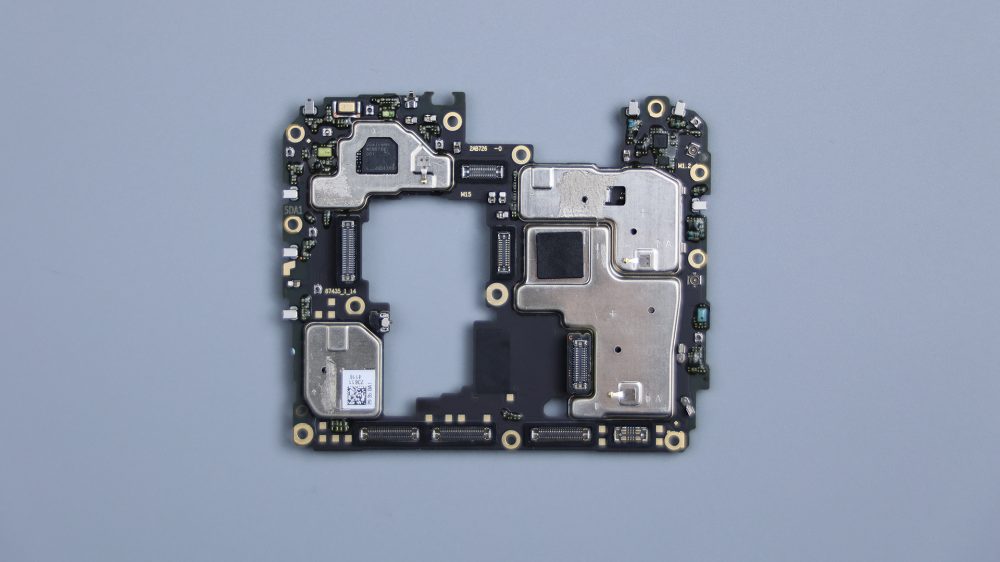
The motherboard is a single-layer design with a very thin PCB, which is good for heat dissipation of the chips and components on it.
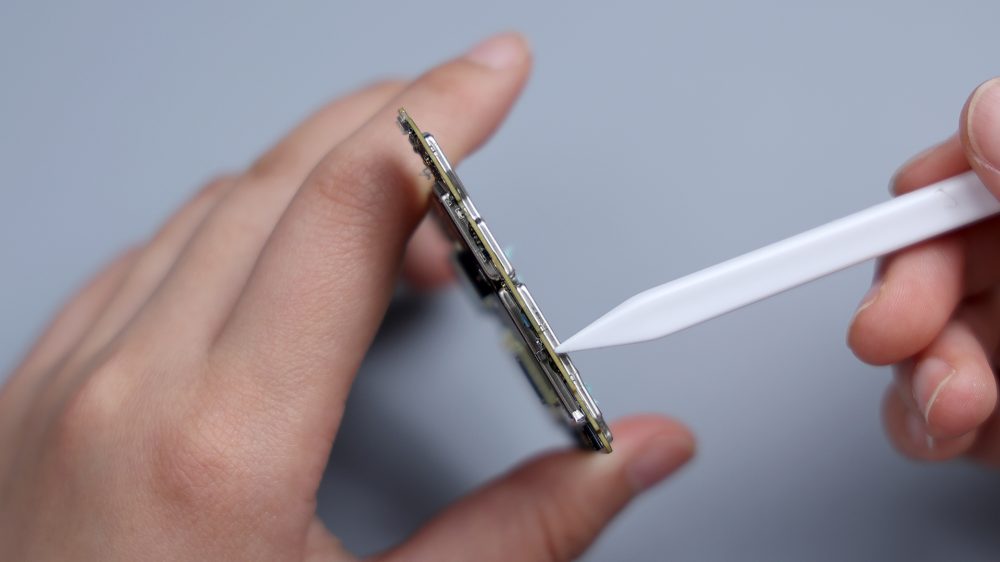
Due to the large size of the main camera and telephoto lens module, it had no choice but to use a broken board to accommodate the two lenses, and the main board in the corresponding position of the two appeared to have a large skeletonization, which was used to reduce the height of the mirror group and try to alleviate the problem of protrusion. In order to facilitate the connection of the motherboard, the BTBs of the three rear cameras have been stacked and padded. As for the hollowing in the center against the bottom, it is reserved for the metal limiting pillar.
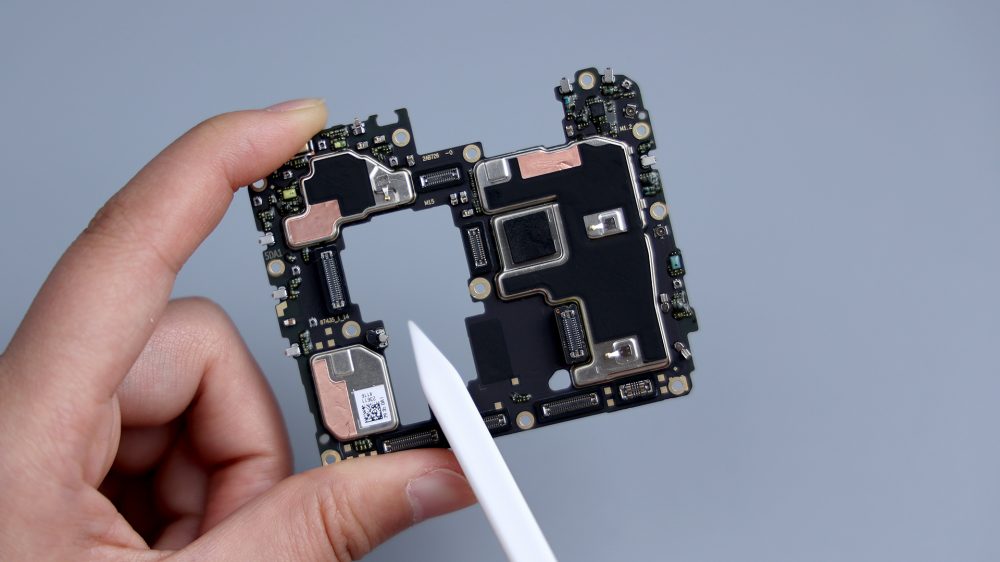
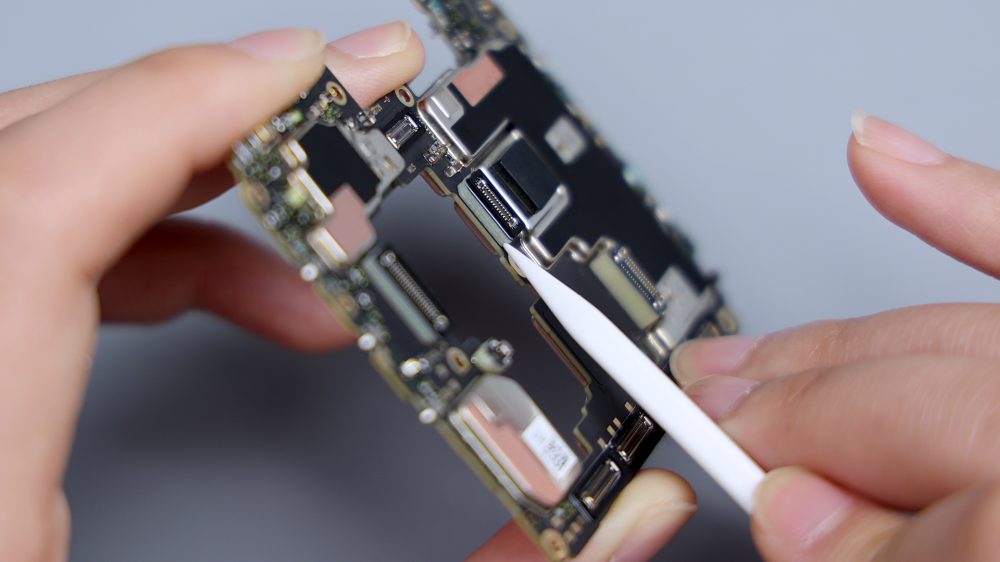
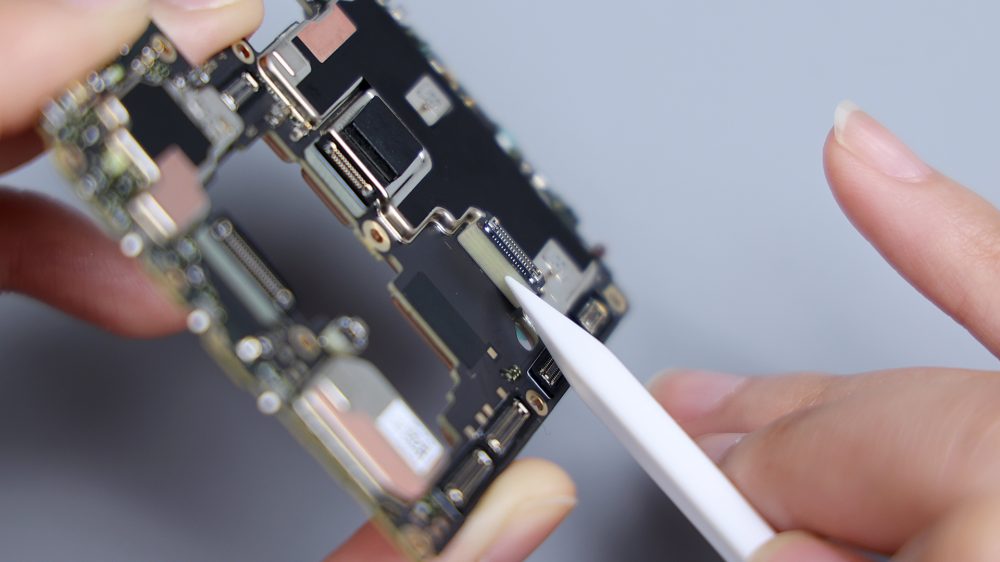
Above most of the shields on the B-side of the motherboard, they are covered with copper foil, and the core is coated with silicone grease to assist in heat dissipation; the capacitors around them are also treated with adhesive, and the round hole in the upper right corner corresponds to the noise-canceling microphone.
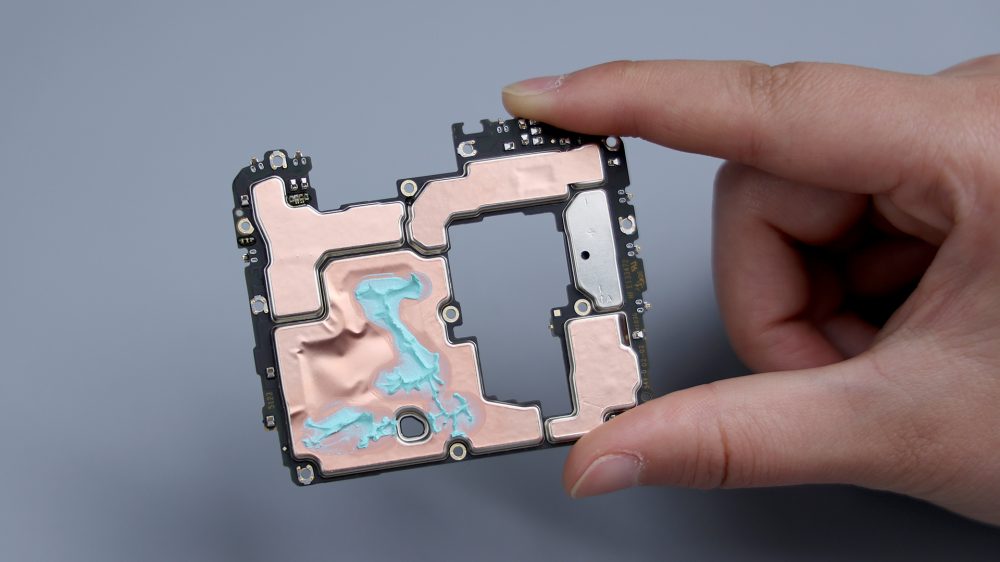
Tear away all the copper foil and heat dissipation film, there is another layer of heat dissipation material underneath them to assist chip heat dissipation.
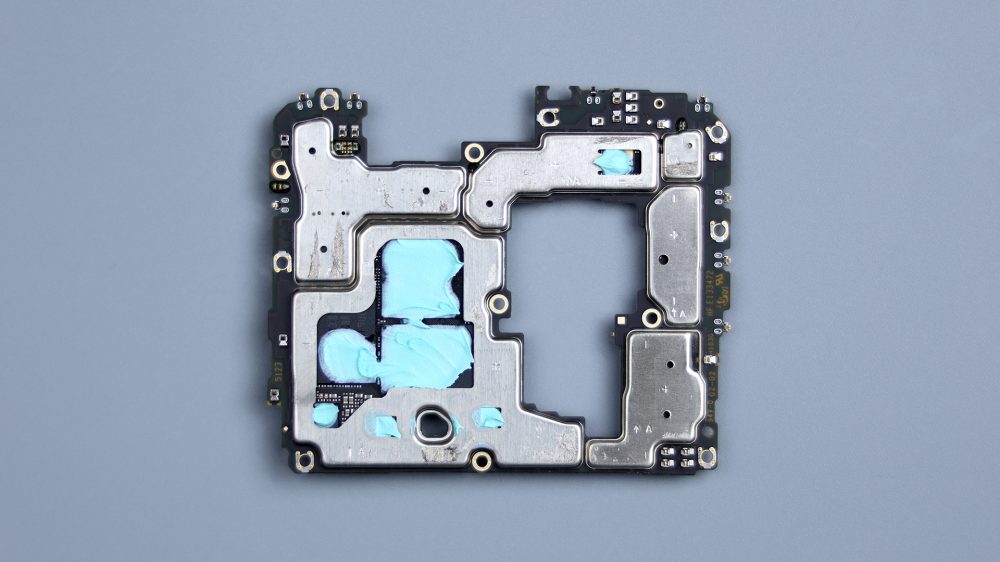
There are multiple chips exposed on the B-side of the motherboard, including the one stamped SM7435, the second-generation Snapdragon 7s processor from Qualcomm, which isn't packaged with the RAM stack but is soldered directly to the motherboard. Right next to it are two slightly smaller chips, both from Samsung, with 12GB of LPDDR4X RAM and 512GB of UFS 3.1 flash storage. Next to the 2 of the same size, is the SC8547 charge pump fast charger chip from Nanxin Semiconductor. Another reflective chip at the corners is the PM7250B power management IC from Qualcomm.There is a chip exposed above the main camera on the A-side of the motherboard, which is the WCN6750 WiFi Bluetooth chip from Qualcomm.
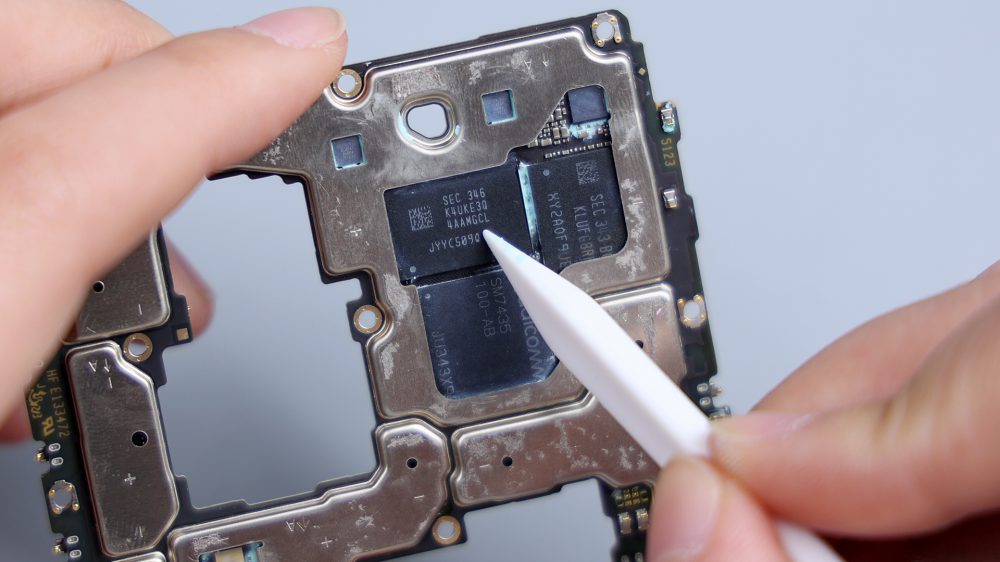
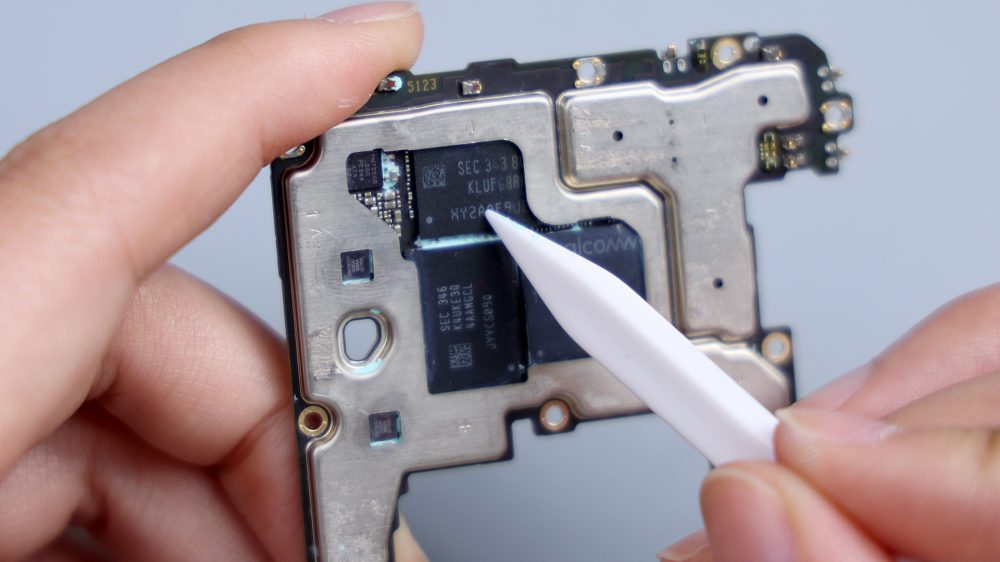
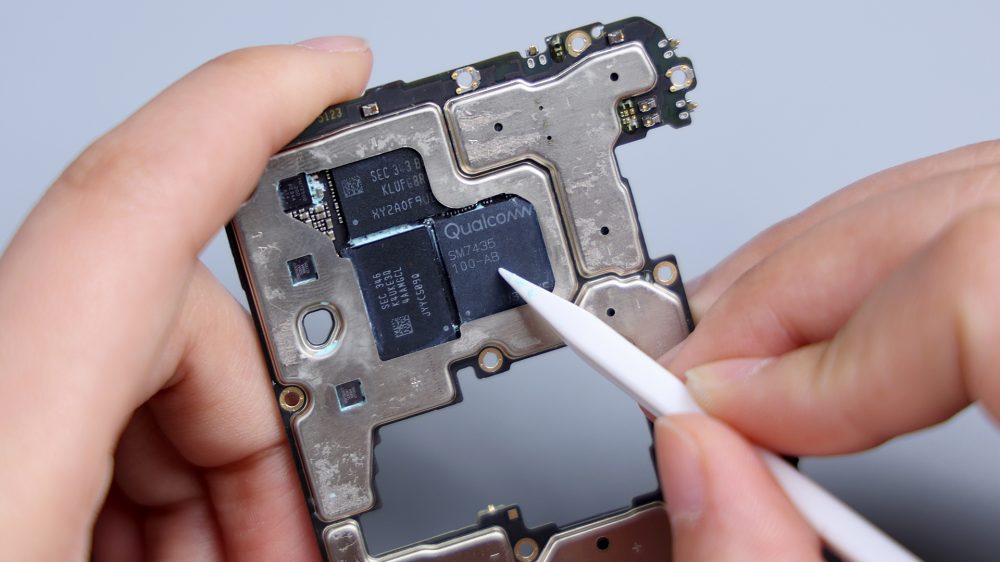
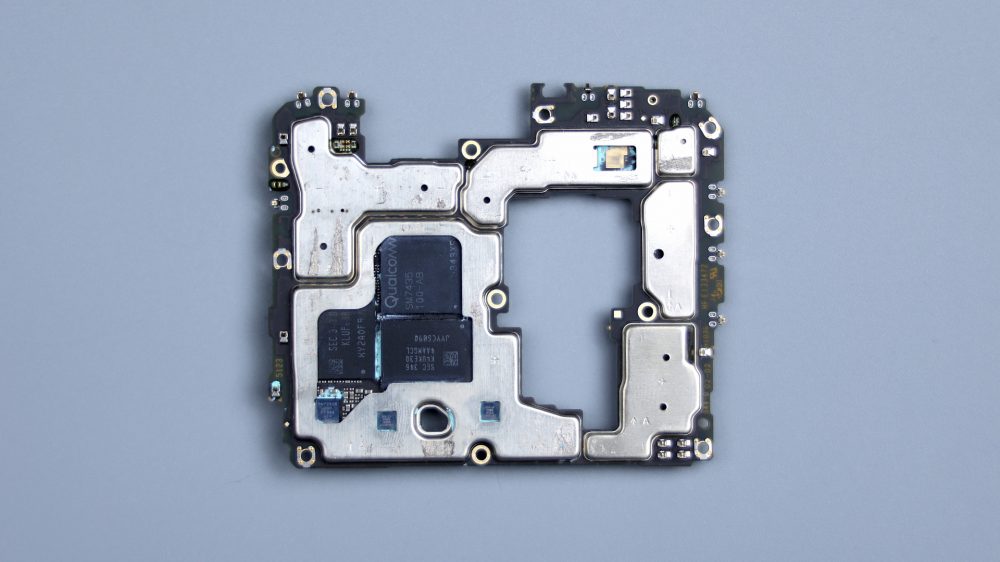
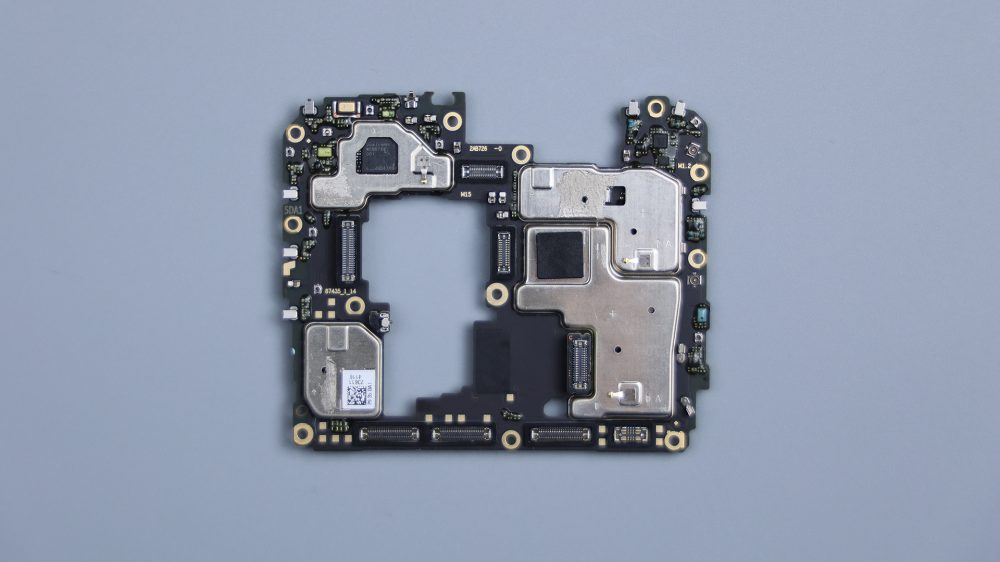
The foam ring at the top left of the center frame roll cage corresponds to the noise-canceling microphone.
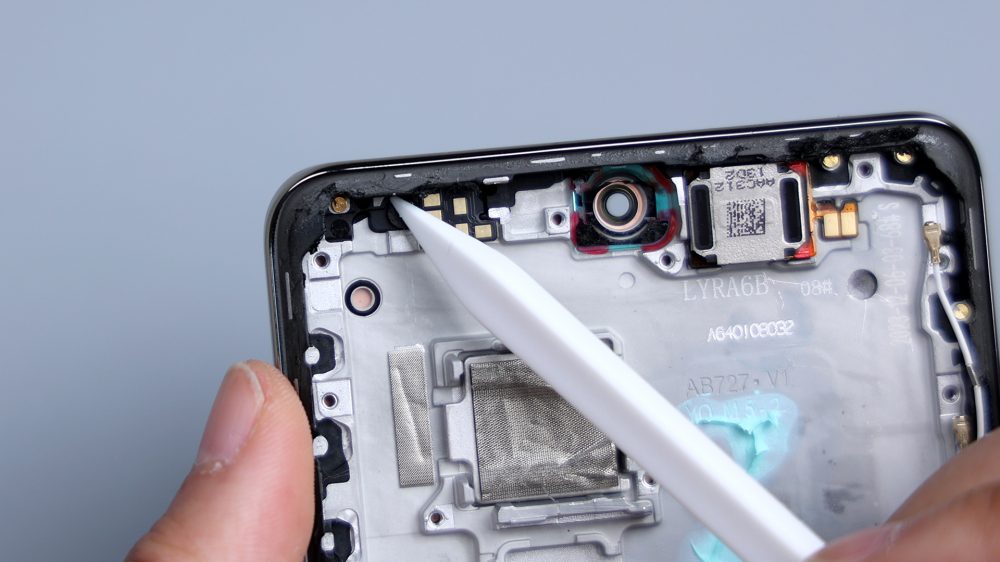
Pry up the small piece of PCB next to it, which has an integrated IR emitter and front ambient light sensor on the back, where the IR corresponds to the position of the screen, with a circular transparent area.
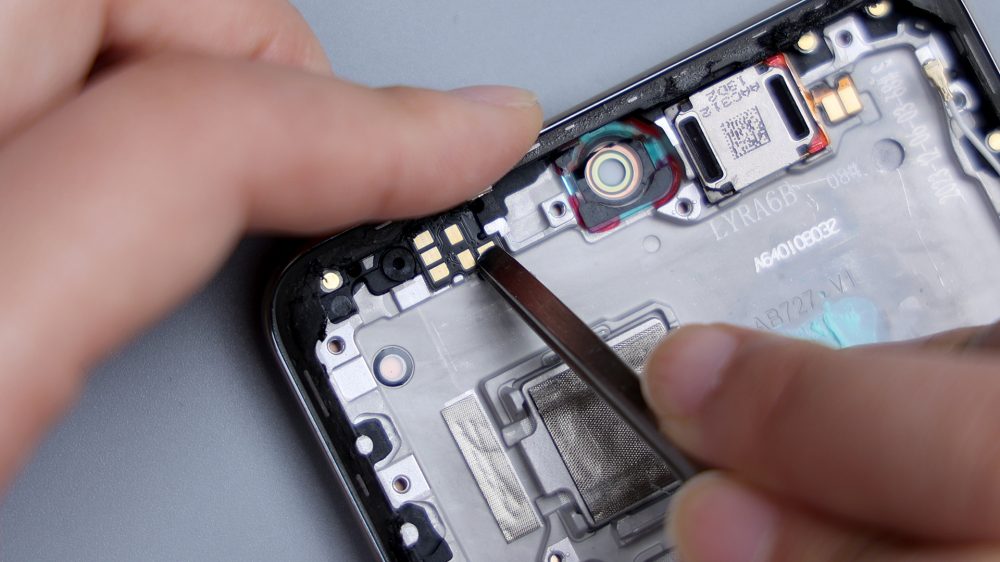
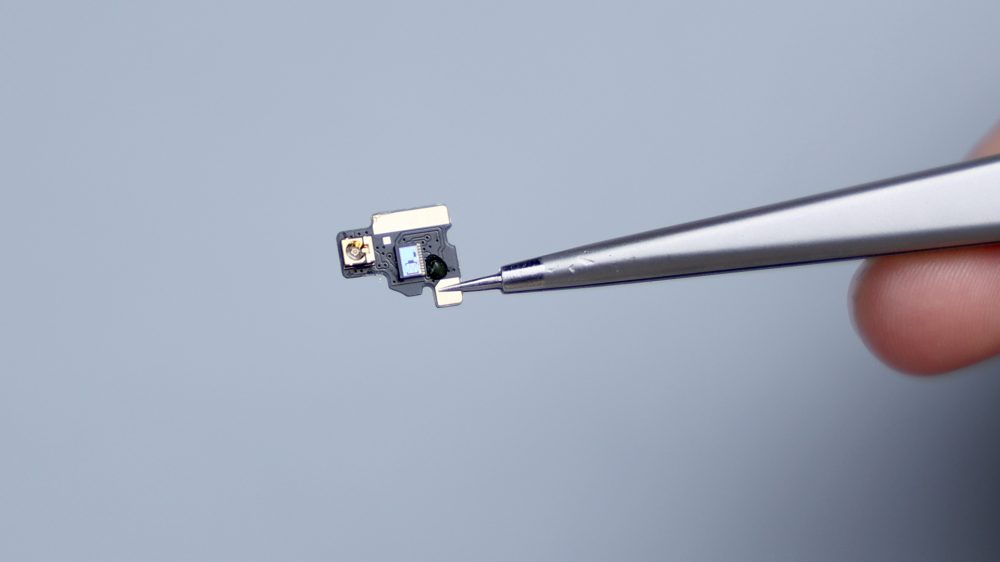
Where the front lens is located, there is a ring of adhesive to assist in fixing it, as well as a foam ring. The top speaker next to it, which also takes care of the earpiece function, is connected to the motherboard via 2 contacts, and it comes from Ruixing Technology with the 1012 specification.
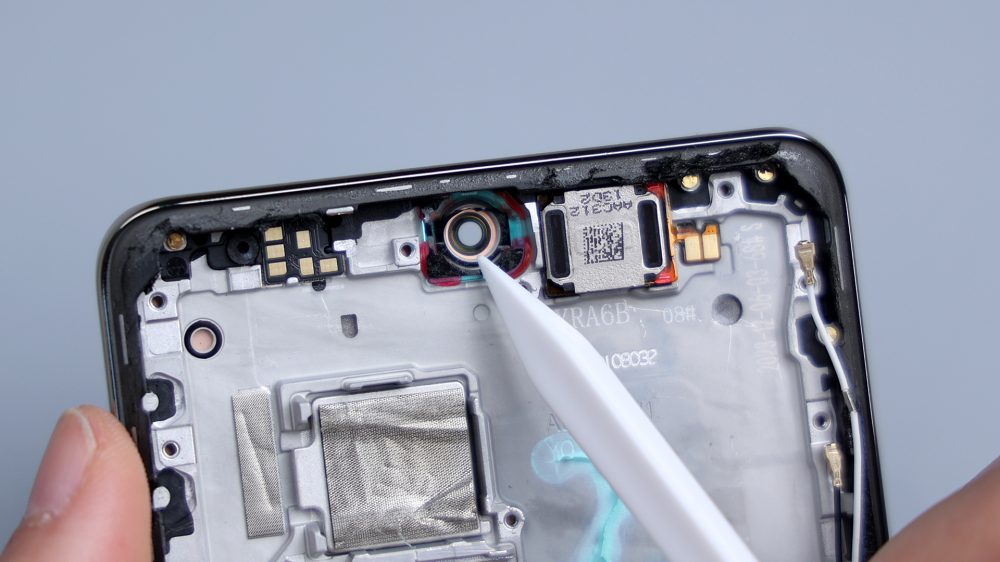
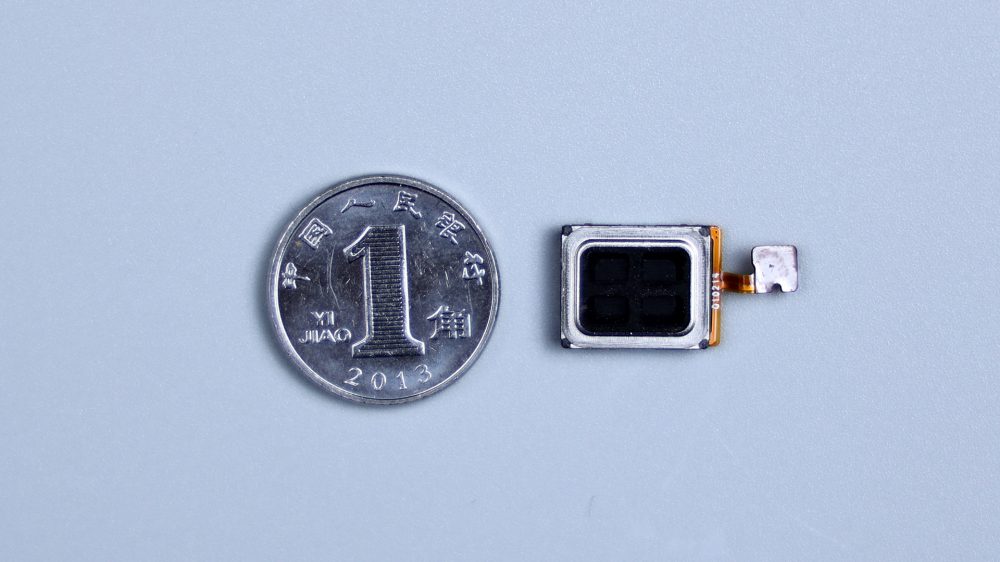
Below the main camera and in the corresponding position of the BTB, there is a conductive cloth. It and the telephoto lens have a metal base that is integrated with the center frame. The four contacts in the lower left corner correspond to the power and volume buttons. Corresponding position of the motherboard core, there is a large amount of silicone residue. The dots distributed around the perimeter are responsible for signal overflow.
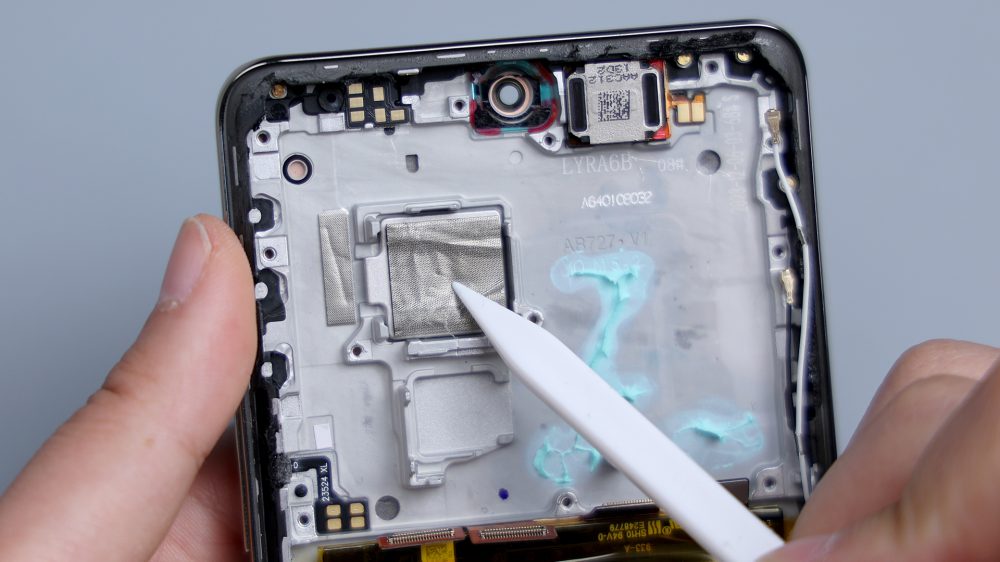
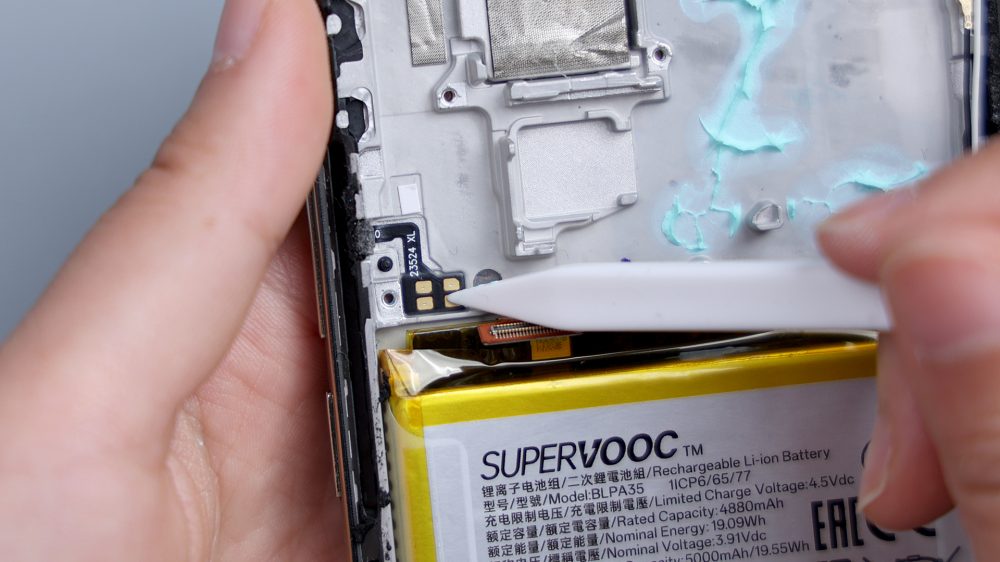
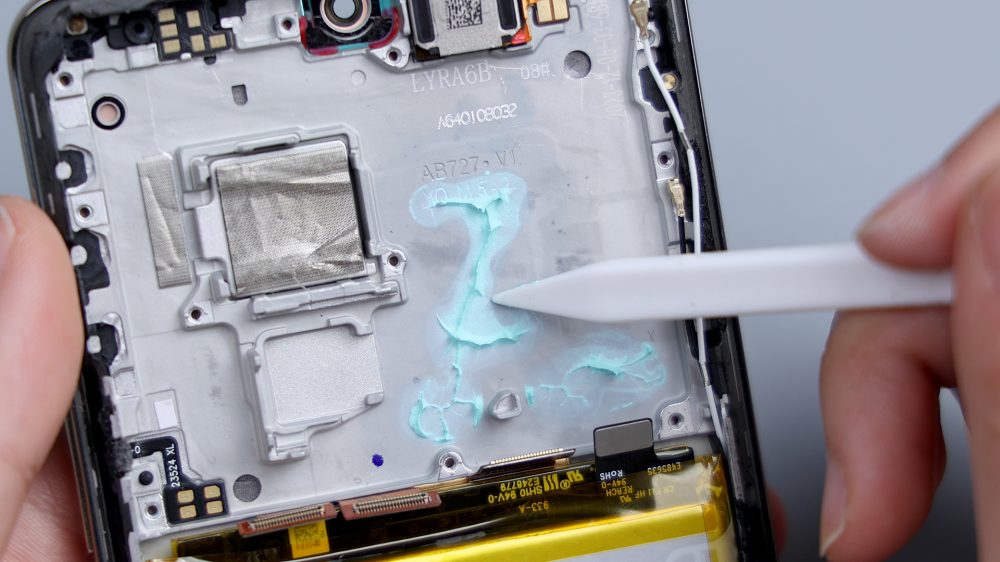
Turning to the bottom, unscrew all the fixing screws in the secondary board area and pry up to remove the cover.
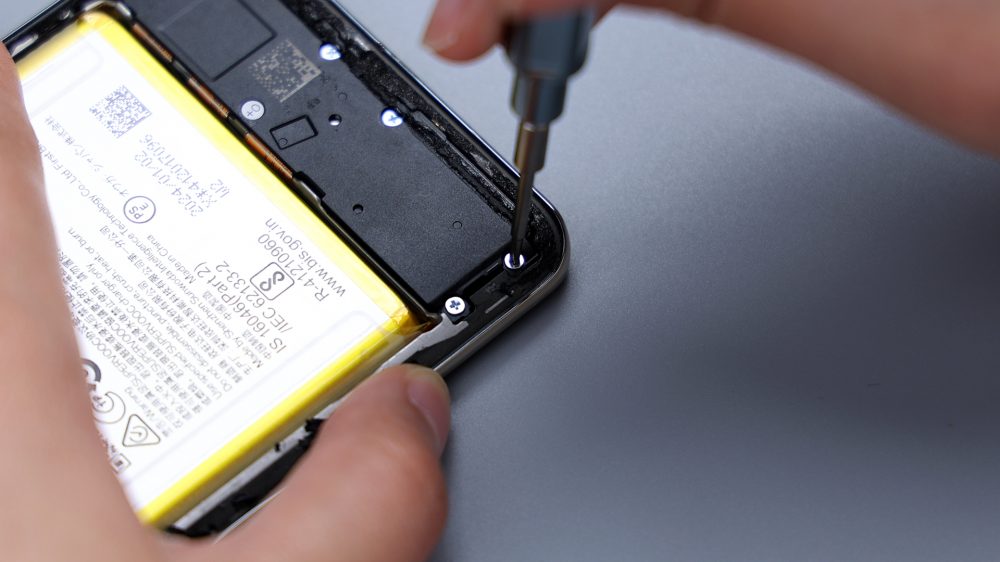
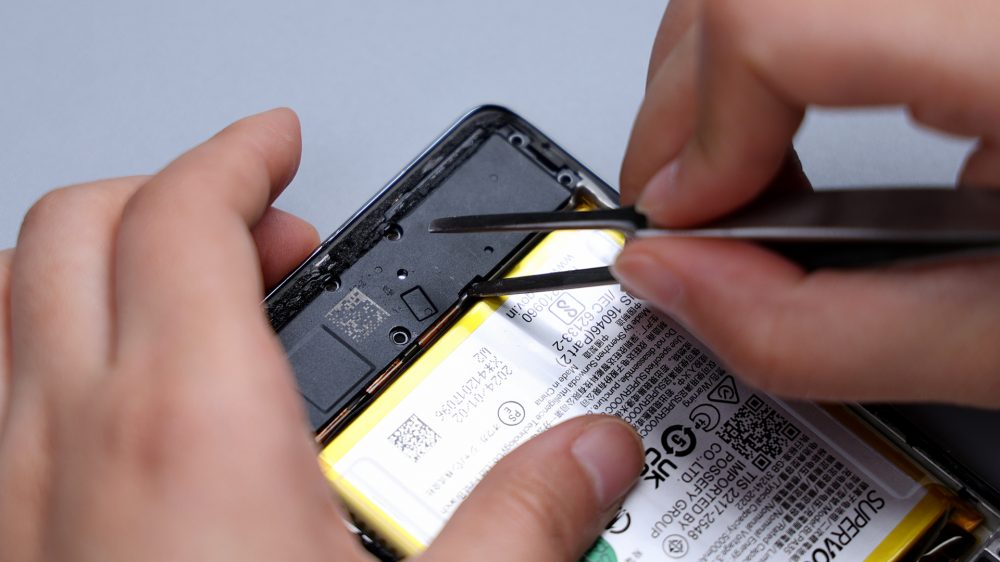
The Realme 12 Pro+ uses an acoustic and haptic integration solution, the bottom speaker and vibration unit are combined into one, integrated on the inside of the cover, balancing space stacking, performance and experience, and connecting to the sub-panel via 4 contacts, it comes from Ruixing Technology, model number 1519, which previously debuted on the Redmi Note 13 Pro+.
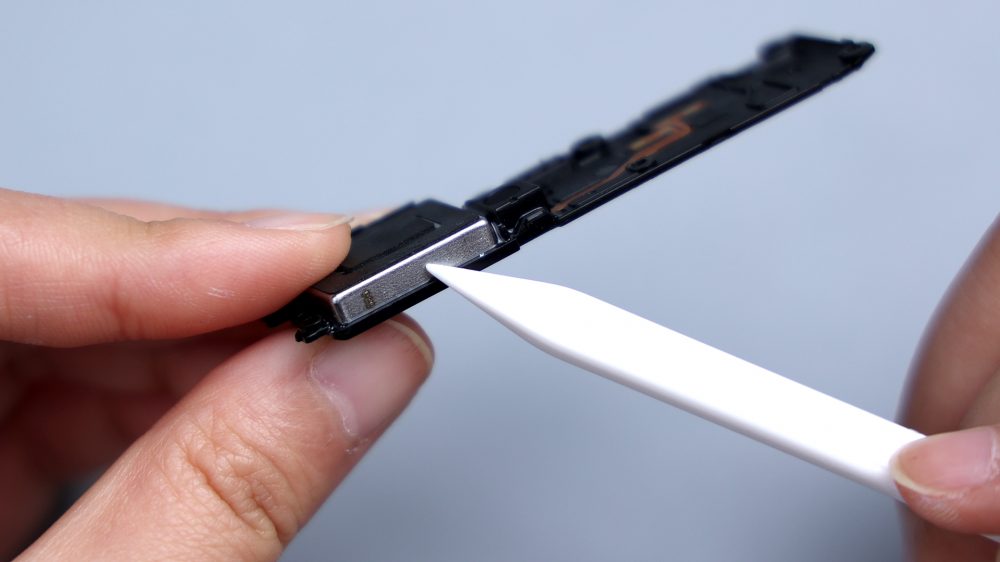
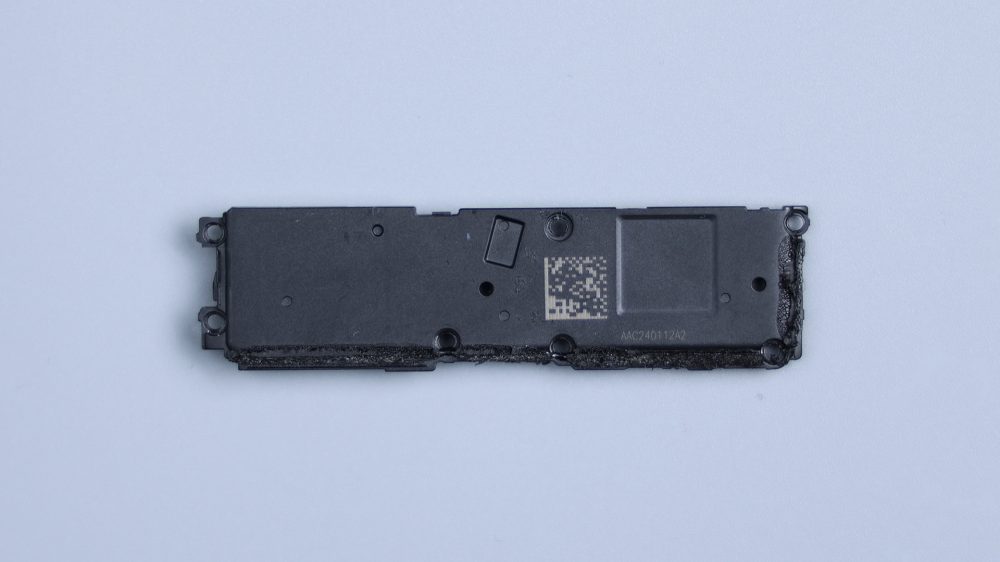
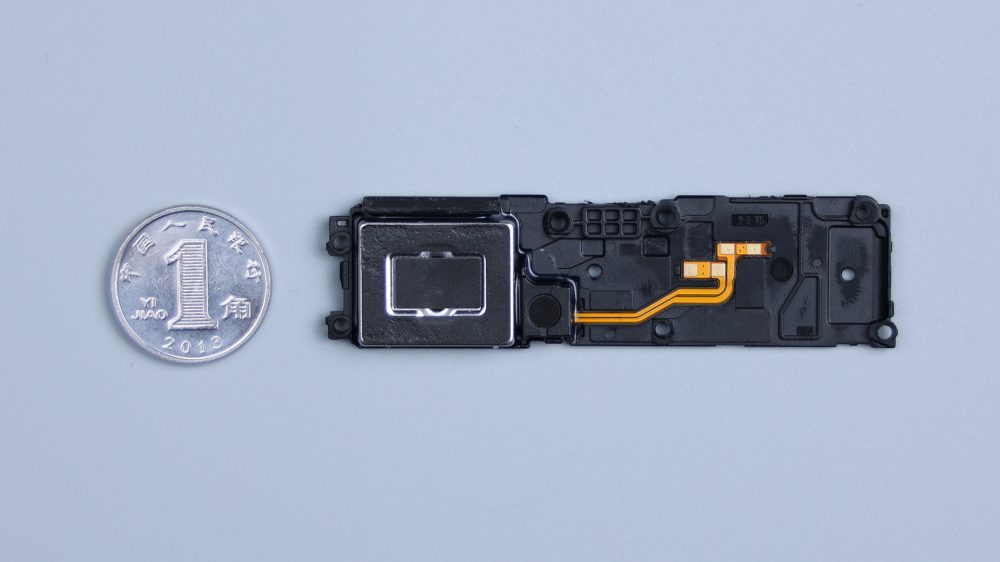
The surface of the sound chamber is covered with a layer of foam, and the round hole next to it features a dust mesh.
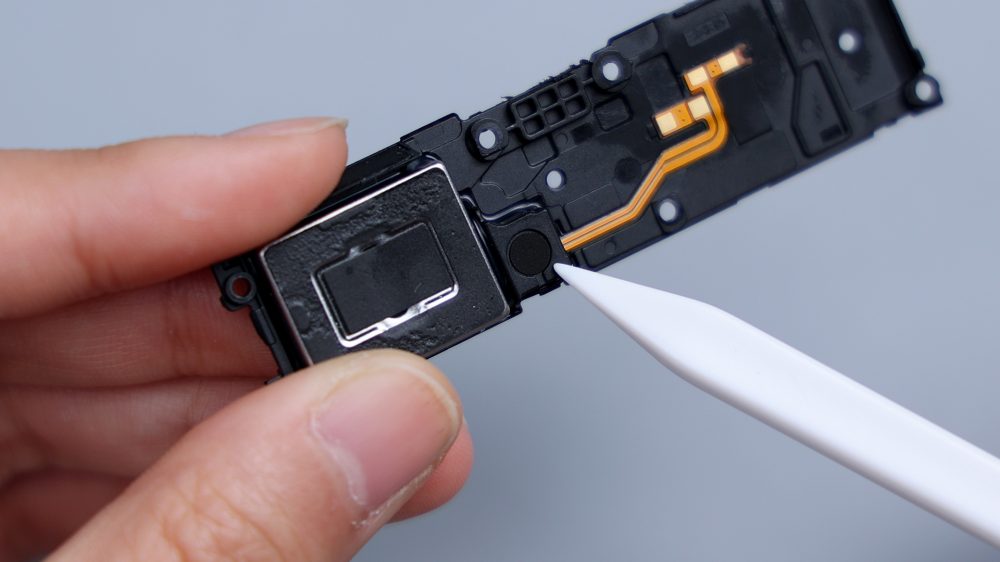
Disconnect the screen, the main and secondary FPCs, and the BTB for fingerprint recognition in turn, and pry up to remove the fingerprint module; the Realme 12 Pro+ uses a short-focus lens solution.
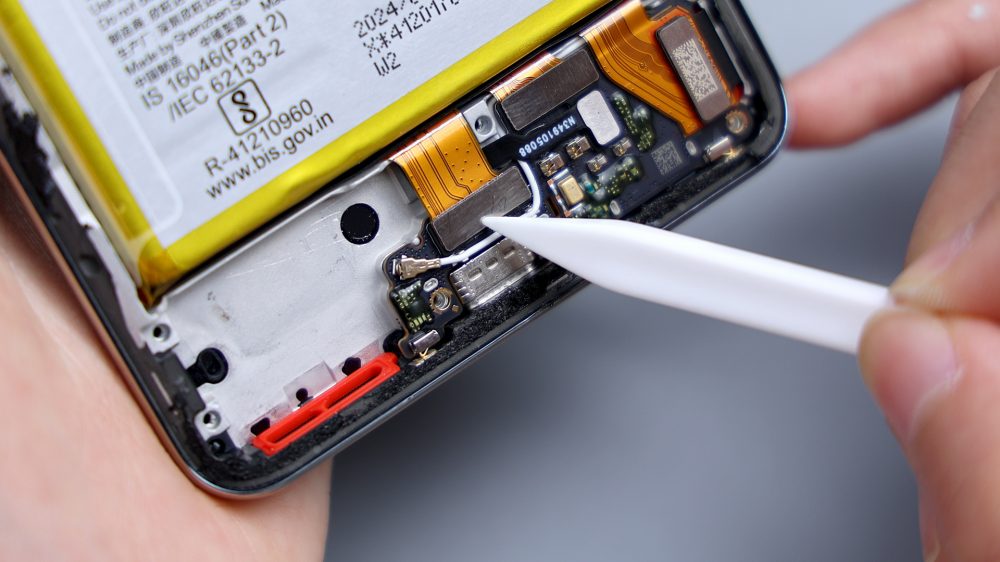
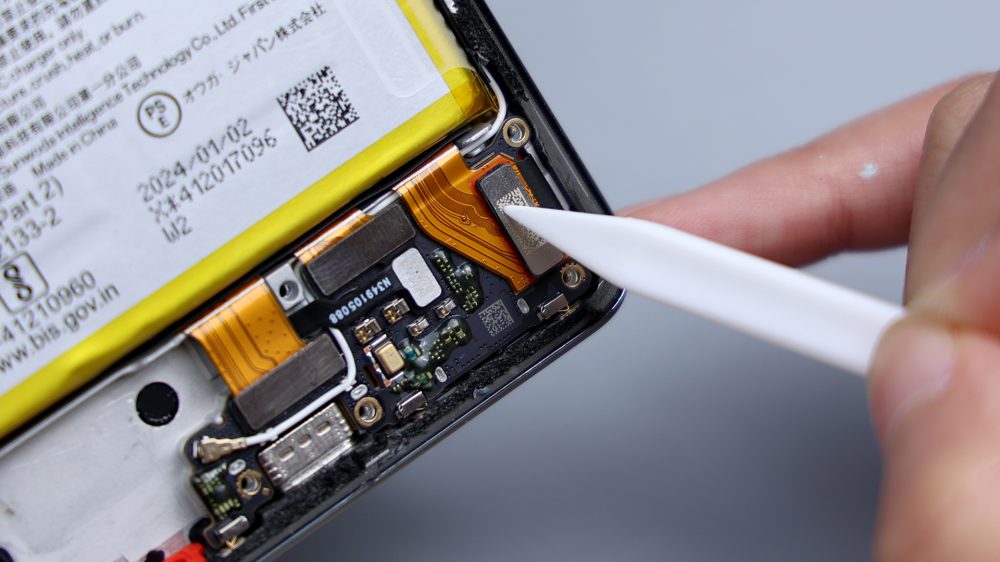
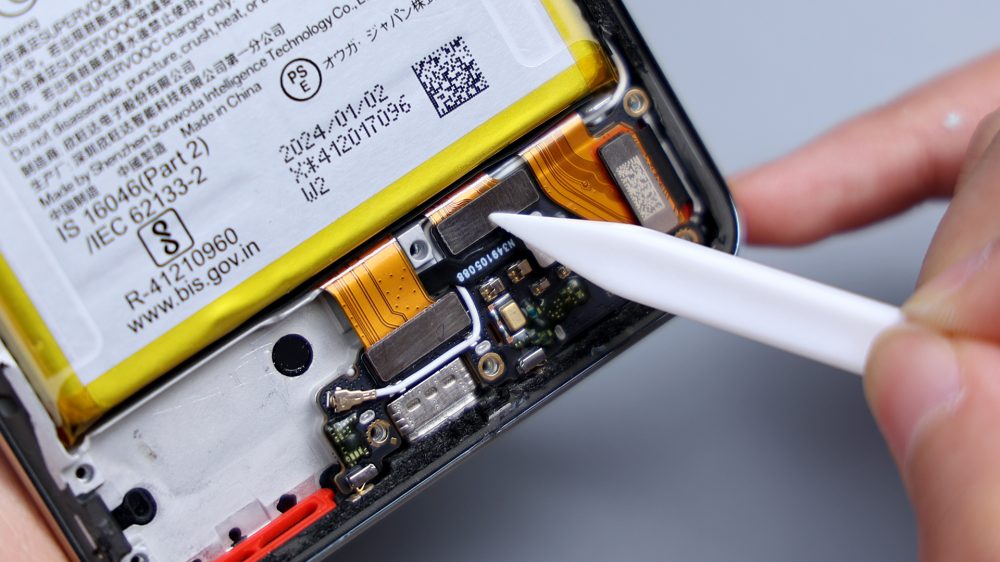
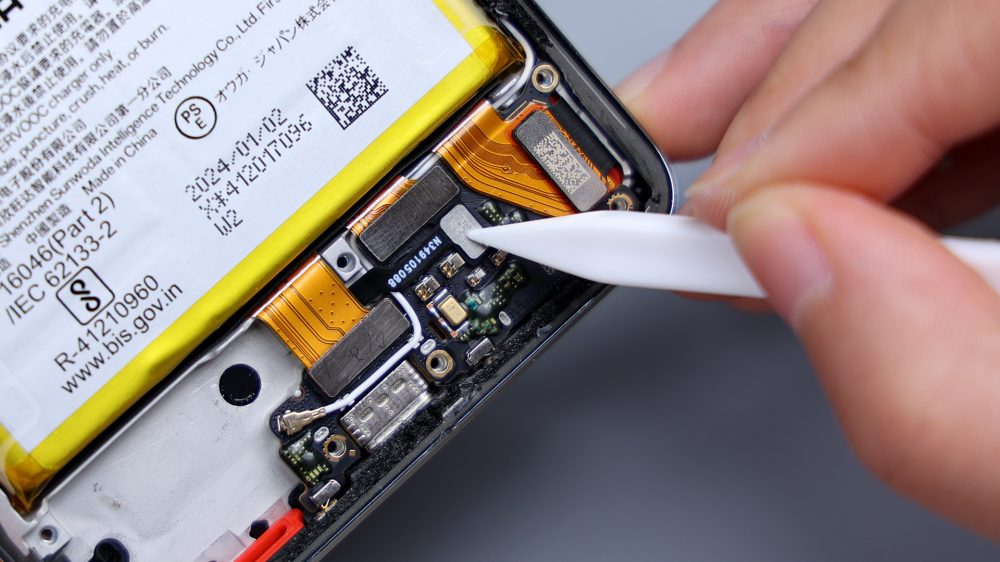
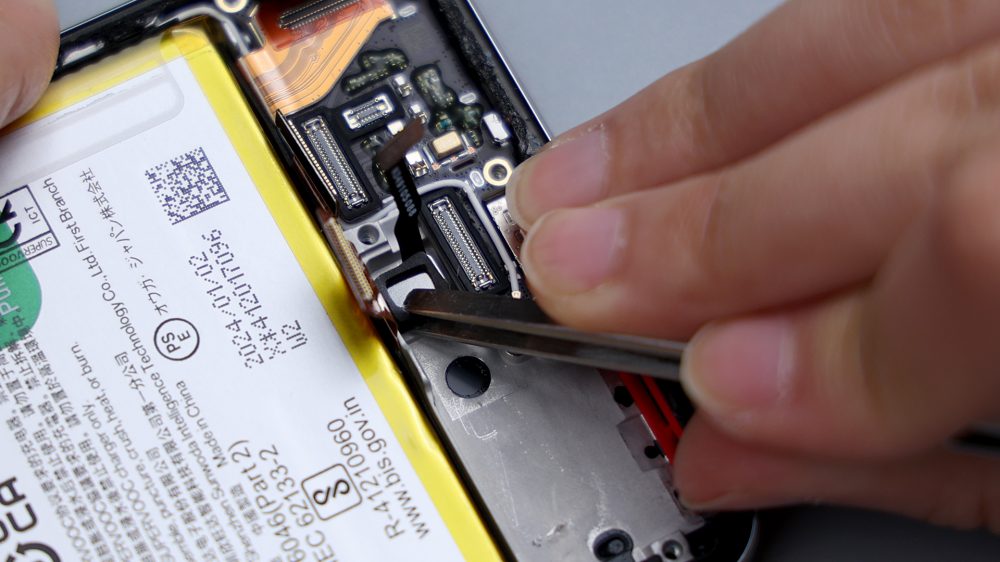
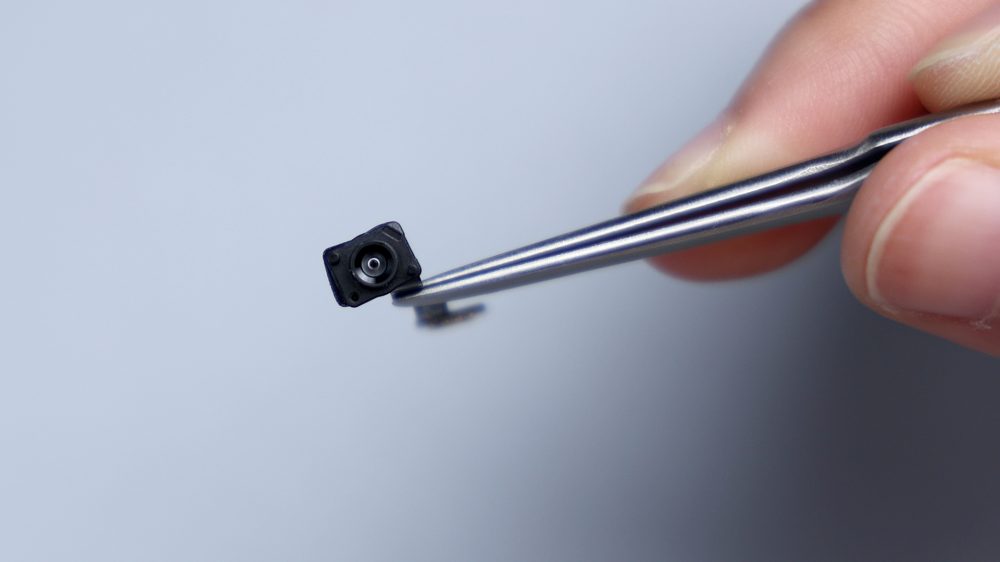
Disconnect the white coaxial cable, tear off the screen FPC and pry up the secondary board, note that there is a black coaxial cable attached to the back of it, disconnect it to remove the secondary board.
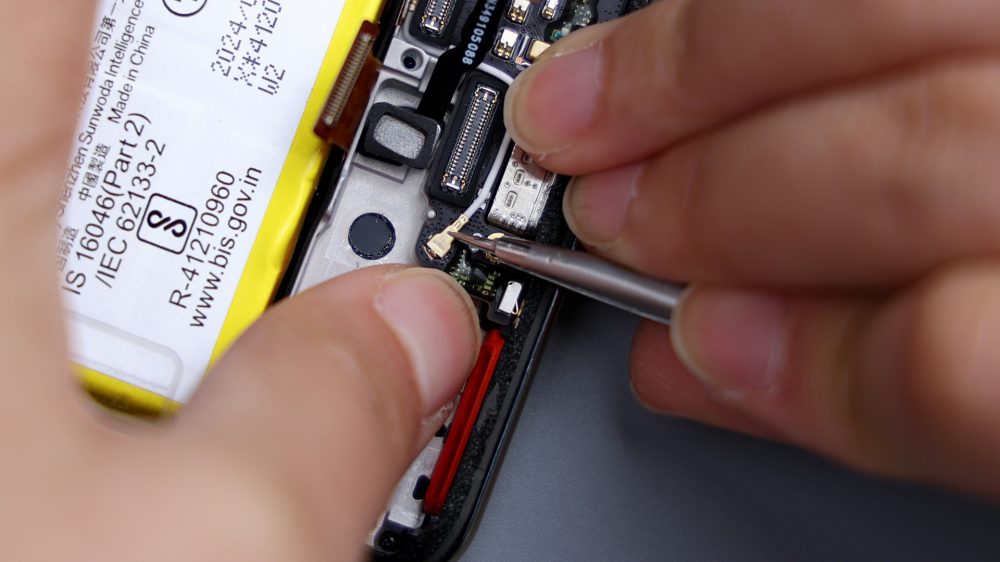
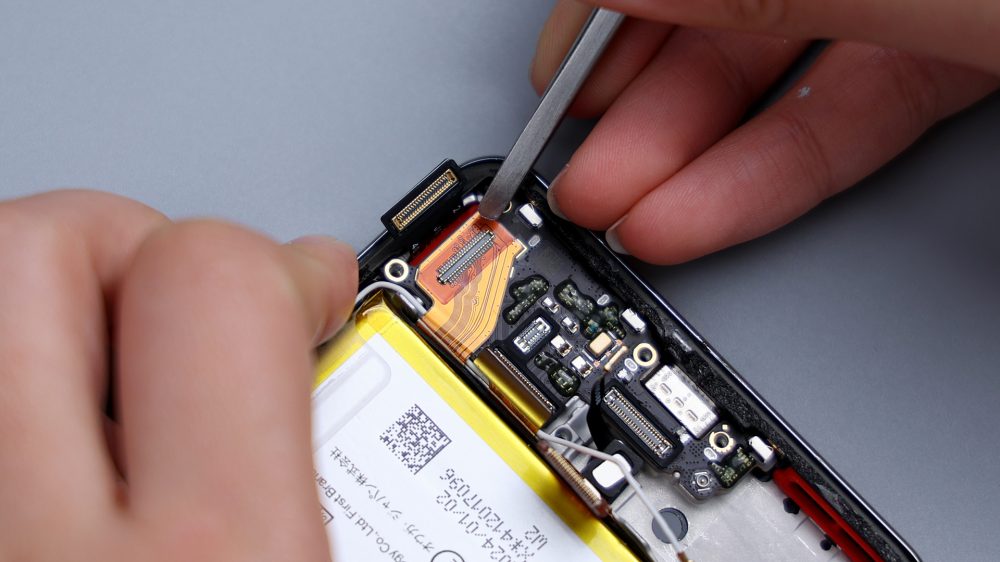
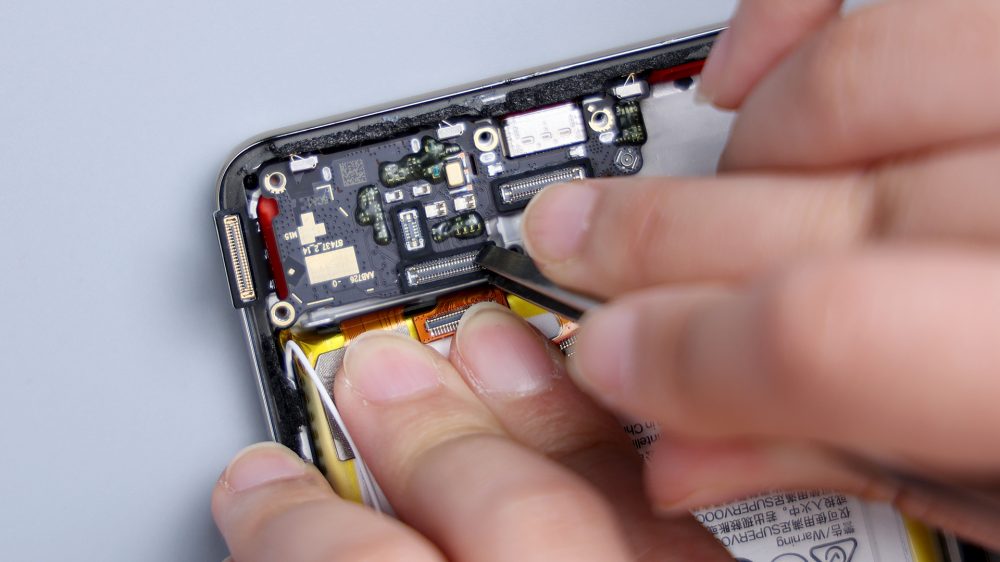
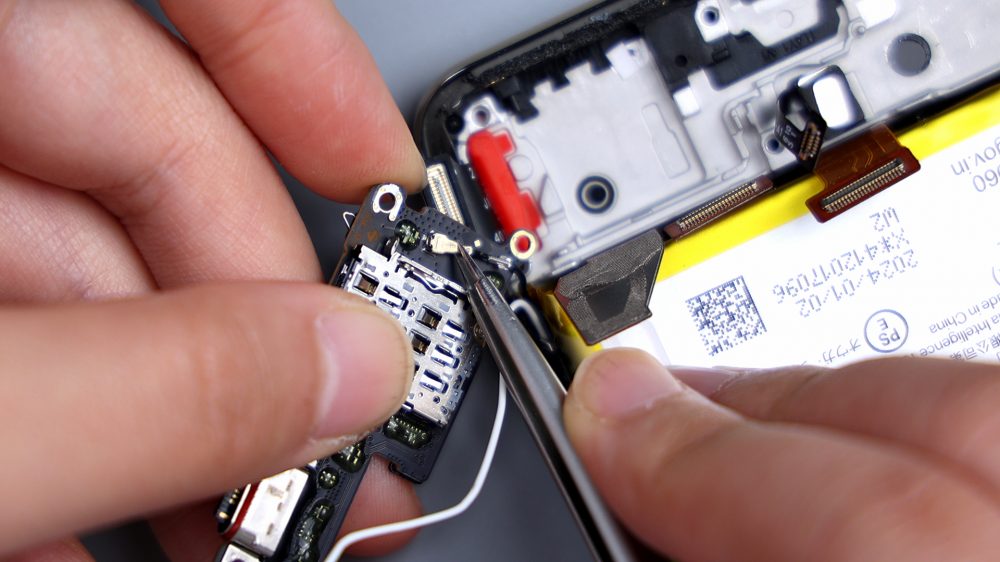
Just like the main board, all the BTB bases on the secondary board are protected by rubber rings, the peripheral capacitors are also a bit rubberized, the microphone is integrated on the A-side, there is no metal cover, and the USB ports have a red rubber ring to protect them from dust and water.
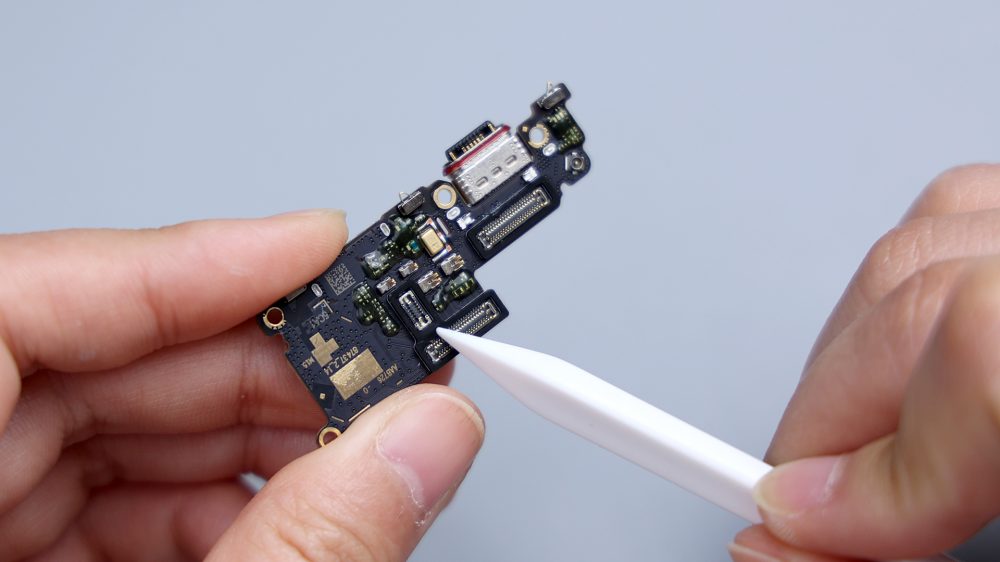
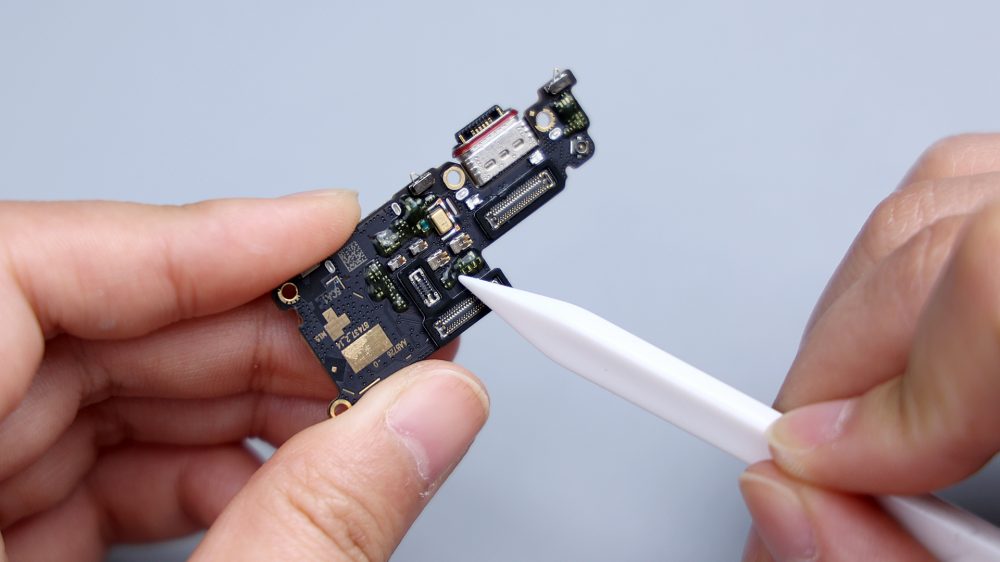
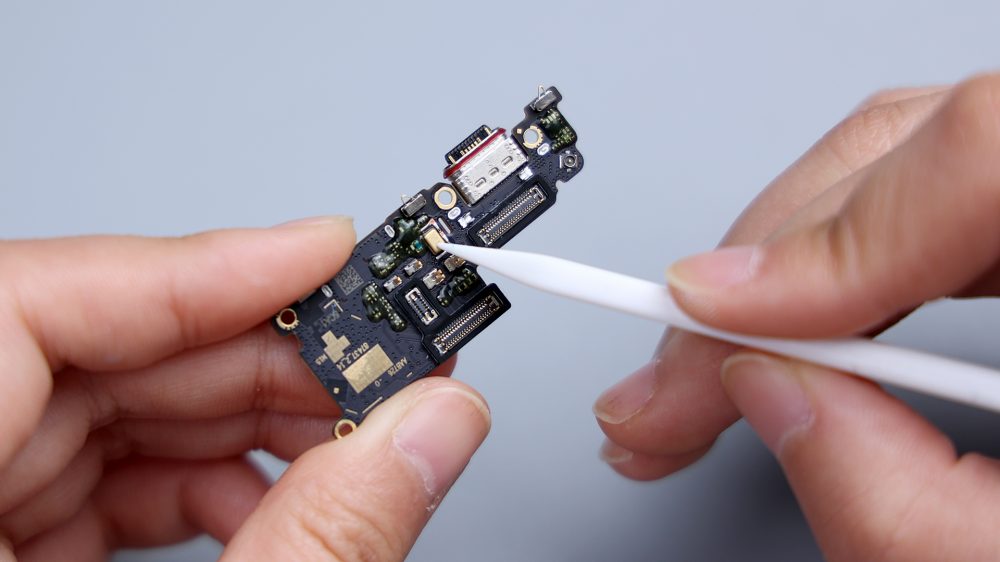
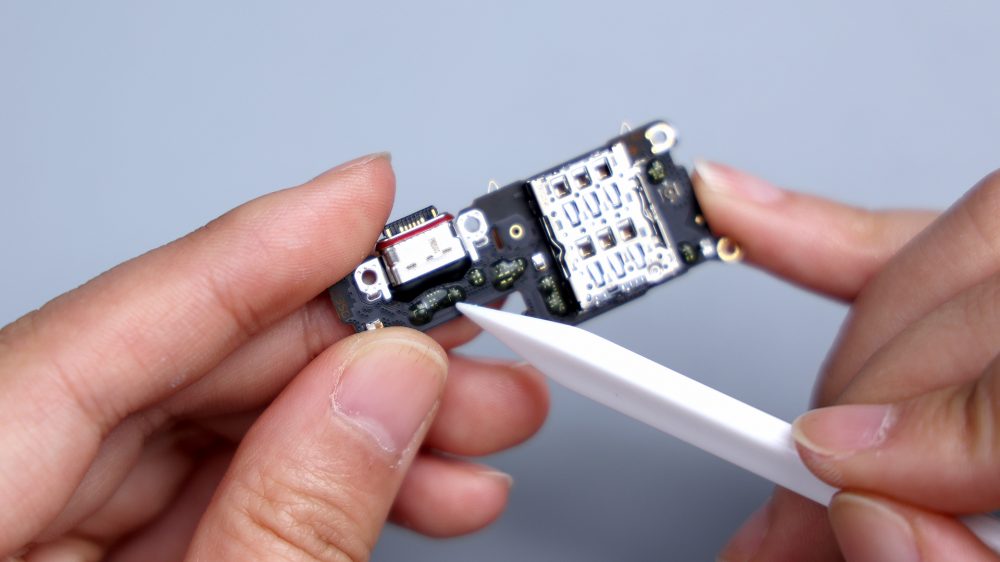
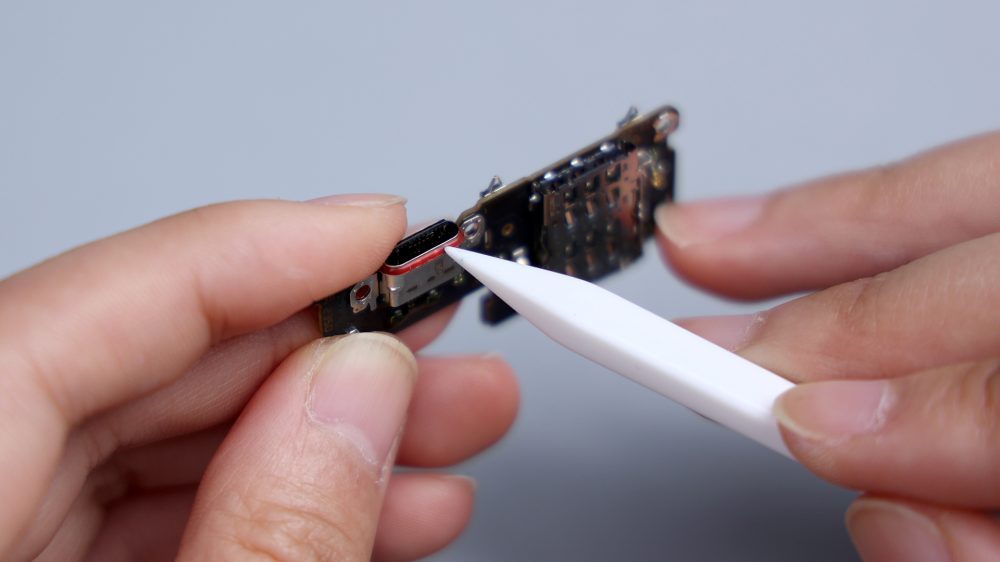
The black foam in the center frame corresponds to the microphone, and it is designed with anti-dumbness underneath to avoid damaging the microphone by jamming the needle. There is also a red rubber ring on the corresponding position of the speaker to enhance the airtightness, and its sound hole is not anti-dumbness, sharp objects will pierce the dust mesh inside.
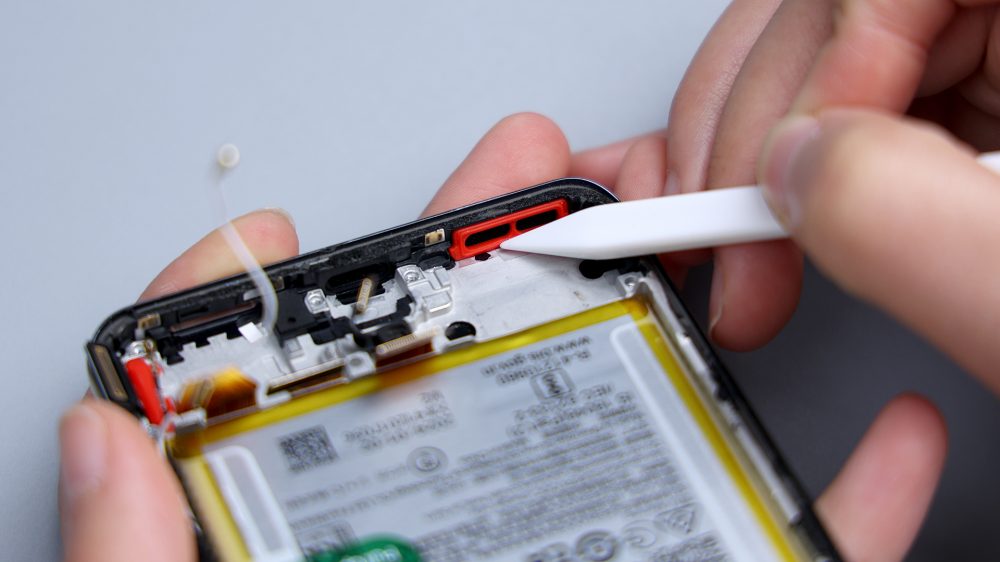
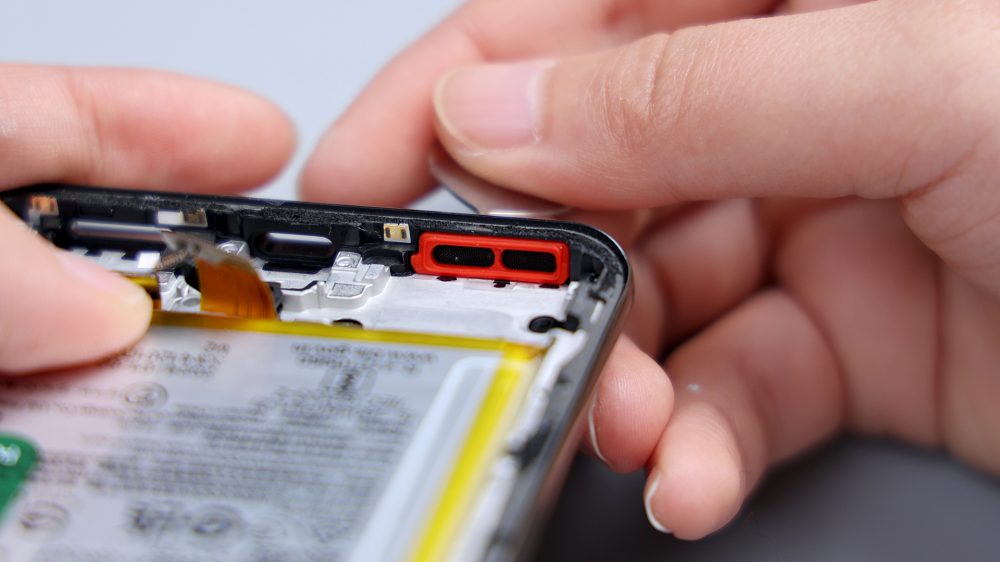
The battery is fixed with one side of easy-open adhesive, according to the diagram, tear the adhesive tape, and lift upward to remove the battery easily.
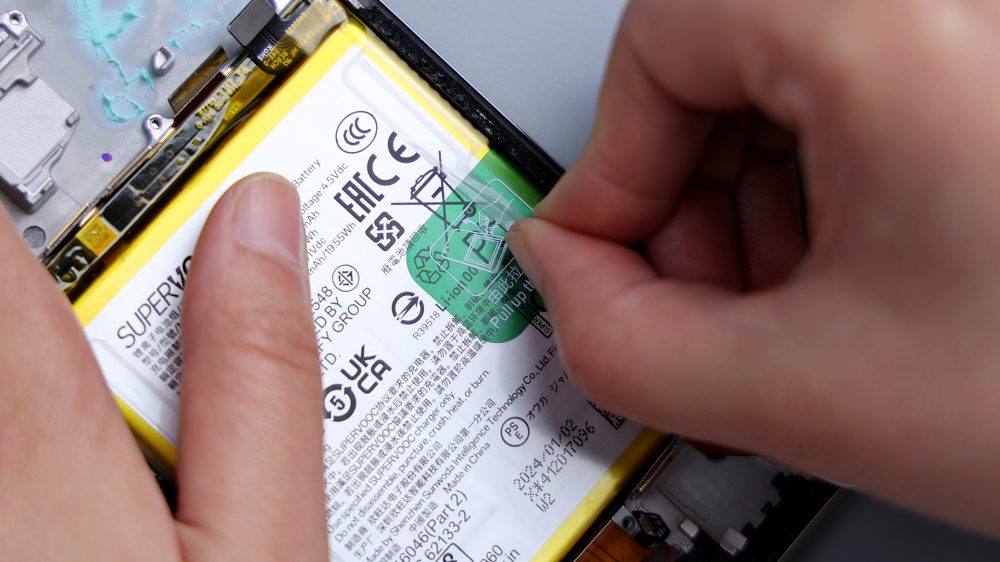
It uses a single-cell, single-interface program with a capacity of 5000mAh, and the manufacturer is Xinda Electronics. The battery cell comes from Lithium Power New Energy, which is a wholly-owned subsidiary of XINWODA, full name is "Dongguan Lithium Power Energy Technology Co. Our products are widely used in smartphones, tablet PCs, laptops, Bluetooth devices, smart wearable devices, drones and other smart terminals.
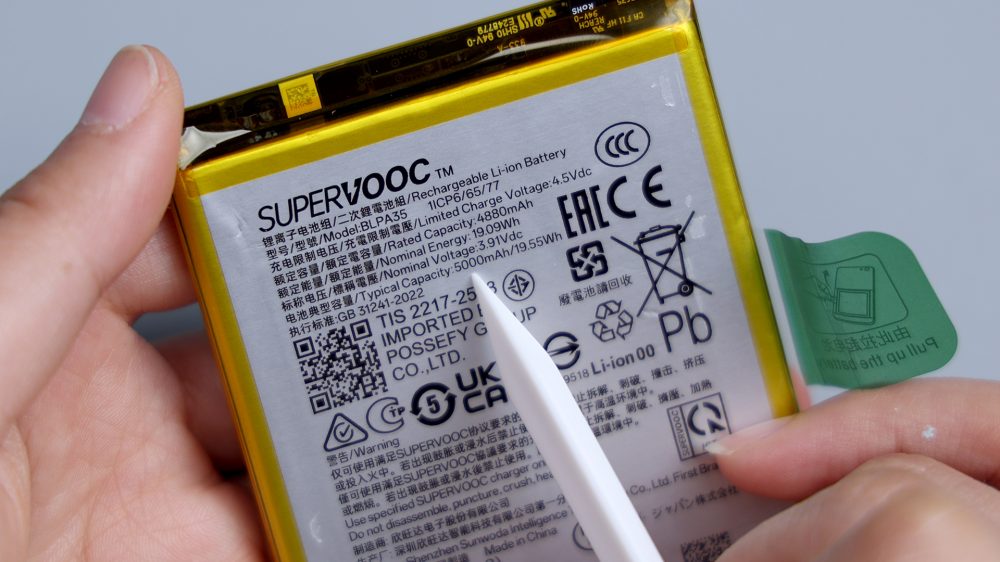
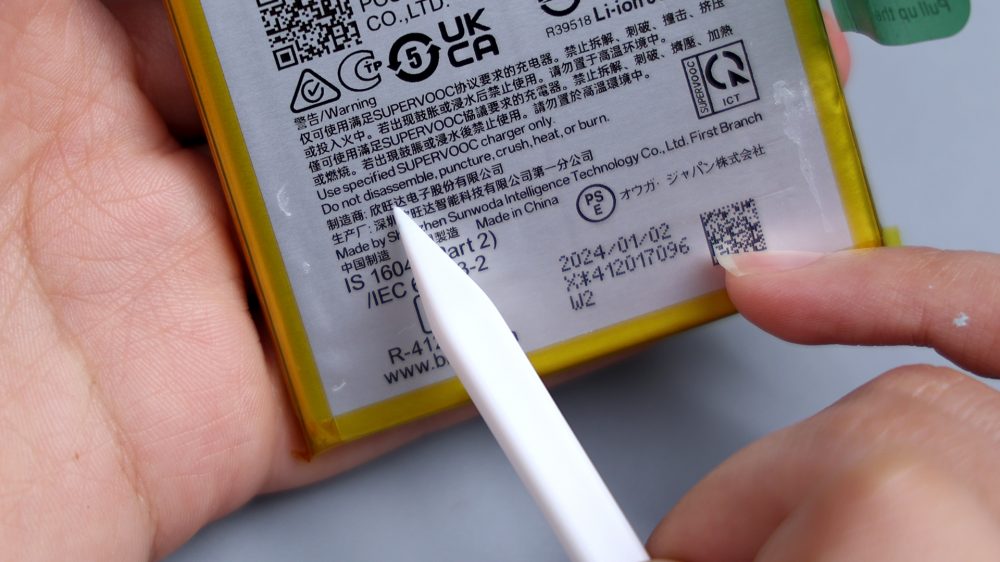
The battery FPC is also attached to a long strip of small boards, from the LOGO on it, the PCB supplier is Shenghong Technology. The frame underneath the battery has a large hollowed-out area, which is in direct contact with the VC heat equalization board to dissipate heat for the battery and the main and secondary FPCs.
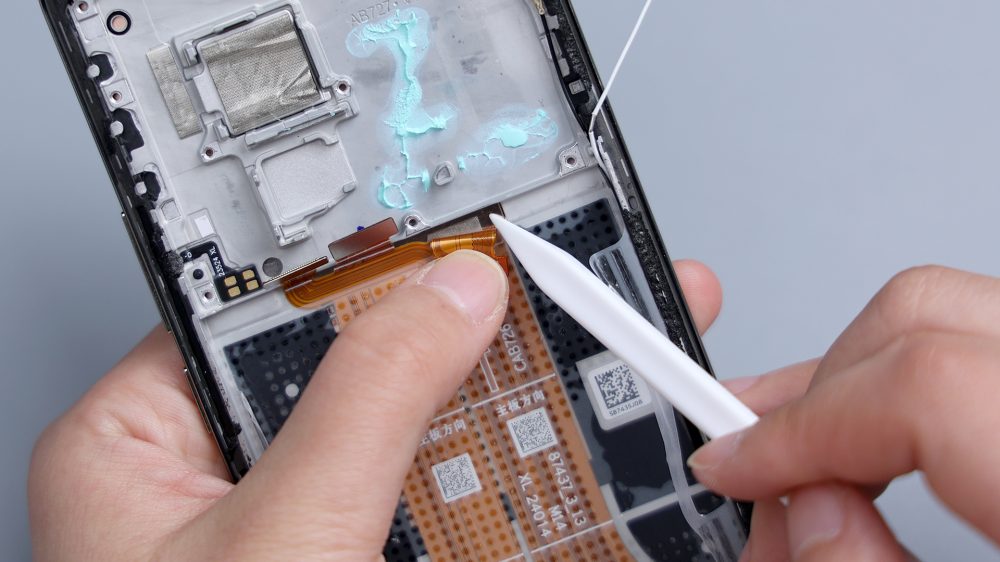
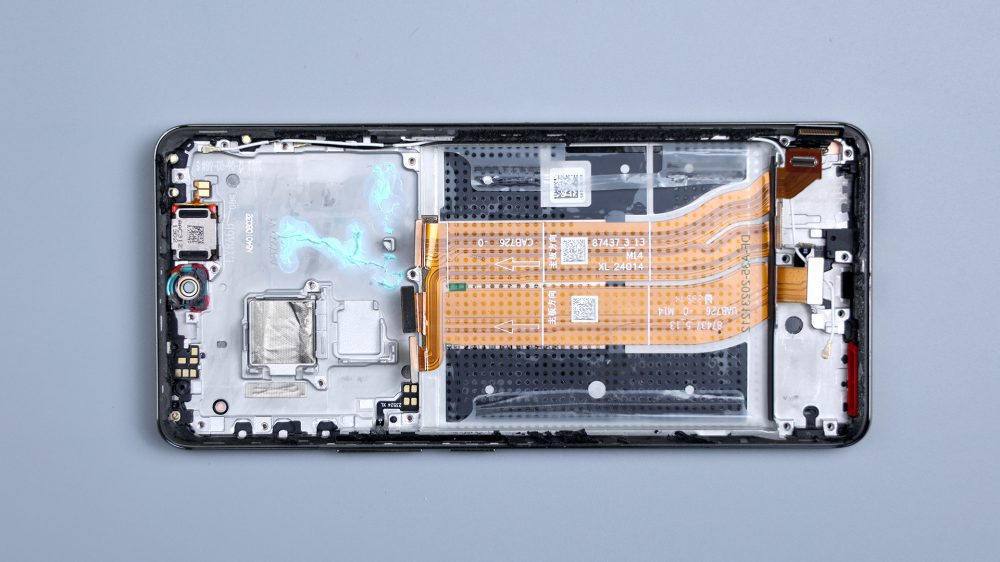
By this point, the disassembly of the realme 12 Pro+ is basically complete. realme's strategy is clear, with a fixed product positioning and budget, more costs are allocated to the exterior design and imaging system. First of all, the face of the project to do a good job, although the "body" is a mid-range machine, but put on a variety of design and decorative embellishments of the "coat", but it does have a bit of high-end style. Secondly, the image side of the farewell 200 million pixels, began to enter the professional photography mode of the track, the flagship main camera + periscope telephoto combination, obviously more practical, but also better to use. Since the budget is limited, the first two increased investment, that other aspects are bound to weaken, the more obvious is the core configuration and fast charging, not strong processor, the level of half a grade of memory and flash memory specifications, moderate fast charging power, these summarized is ...... bland. And this "bland", in the internal structure and workmanship materials are also reflected, take off the "gorgeous coat", revealing the appearance of the mid-range machine should have, regardless of the degree of sophistication or detail processing, compared to the real flagship machine or a grade worse.
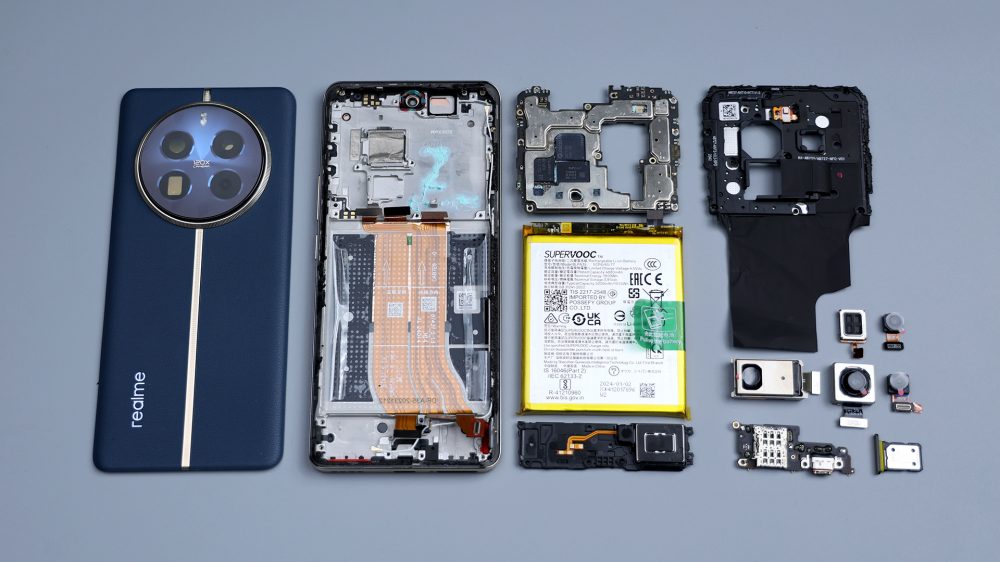
In addition, through the disassembly, we also found a "little secret" of the Real Me 12 Pro +, that is, in terms of configuration and components, and last year's release of the Redmi Note 13 Pro series are partially similar, for example, with the Note 13 Pro with the same second-generation Snapdragon 7s processors and LPDDR4X RAM, and the same UFS 3.1 flash memory as the Note 13 Pro+, as well as the same integrated speaker and vibration unit solution from Ruixing Technology. This is also a side note, the world in addition to a few brands with a high proportion of independent research and development, most manufacturers of cell phones are still restricted to the supply chain within the technical barriers, once you choose a certain processor, and have a product focus, the rest of the supporting components and chips, the choice is not large, or even only a set of solutions can be selected, you want to DIY combinations can not be, which is the same for the brands at the same price level product homogenization, the same UFS 3.1 flash memory, and the same speaker and vibration unit from Ruixing Technology. This is also one of the core reasons for the serious homogenization of products of various brands at the same price level. Regarding the purchase, the Realme 12 Pro+ is obviously suitable for users who place more emphasis on imaging functions and do not have high requirements for core configuration and extreme performance.
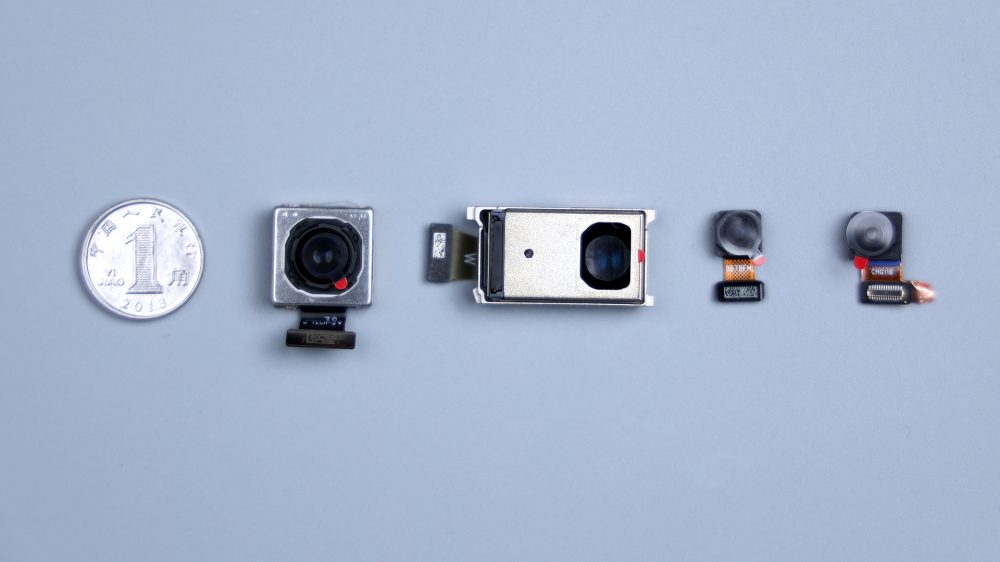
The usual rules, the end of the chat a disassembly-related topics, this issue is to say that the SC8547 charge pump fast-charging chip used on the Realme 12 Pro +, as well as the South Core Semiconductor behind it.
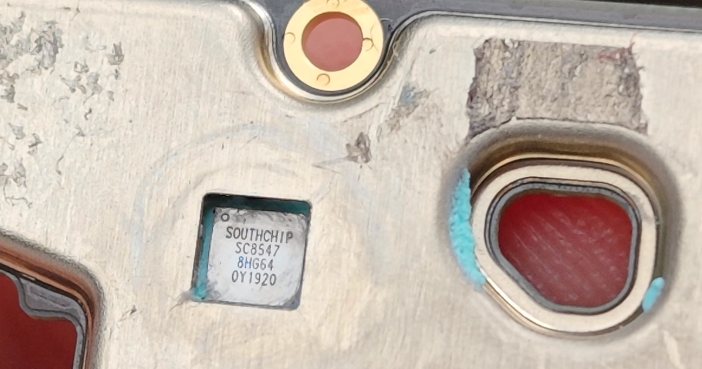
The SC8547 is mainly used for input step-down to charge the battery, has a charging efficiency of more than 98%, supports 33W super fast charging, integrates 10-channel system protection, 6-channel charge pump protection, 7-channel 12-bit ADC, and supports the VOOC protocol. It adopts CSP-36pin, 2.62*2.62mm package, which is not only suitable for cell phones and tablet PCs, but also can be assembled in wearable devices. Shanghai Nanxin Semiconductor Technology Co., Ltd. is a domestic semiconductor design company focusing on power supply and battery management, with charge pump, DCDC, ACDC, wired charging, wireless charging, fast charging protocols, Li-ion protection and other product lines, providing a complete fast-charging solution from the AC to the battery side, with products covering the range of 10W-200W, and its charge pump high-power fast-charging series products Taking the lead in breaking the foreign monopoly, it has passed the stringent tests of many domestic cell phone brands and realized large-scale and stable mass production. Previously, many cell phones under Huawei, Glory, Xiaomi, OPPO, vivo, Lenovo, and Motorola have been equipped with chips of Nanxin Semiconductor. NSC's fast charging solutions are also widely used in the fields of wired chargers, wireless chargers, car chargers, mobile power supplies, energy storage power supplies, etc. Brands such as Samsung, Bull, ZiMi, Lixun Precision, Anchor, DJI, etc. have also adopted NSC's related technologies and solutions.

